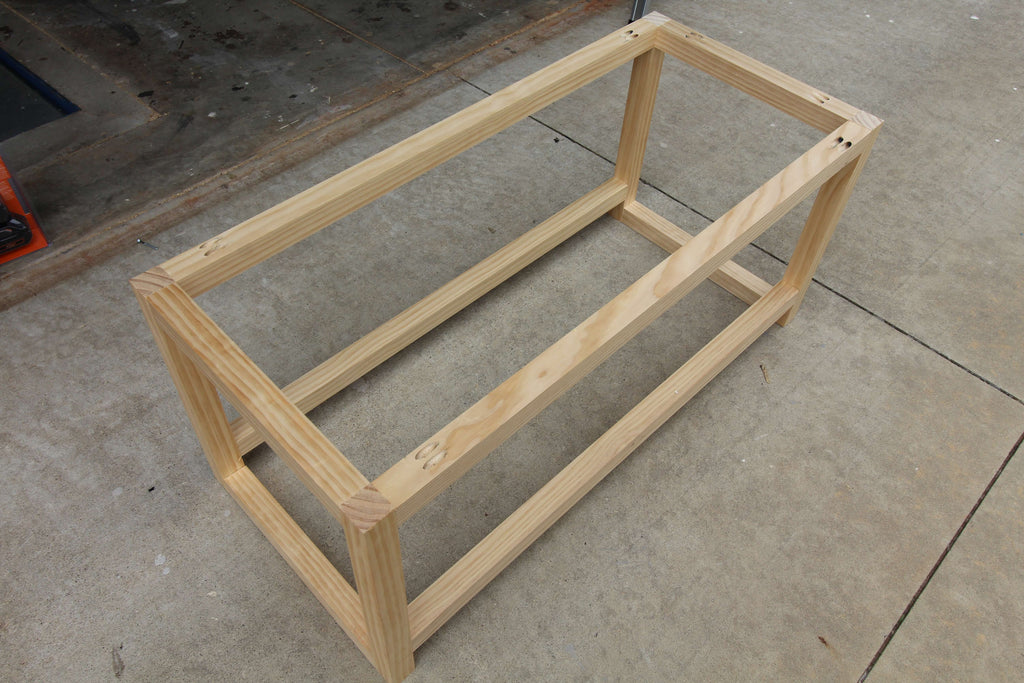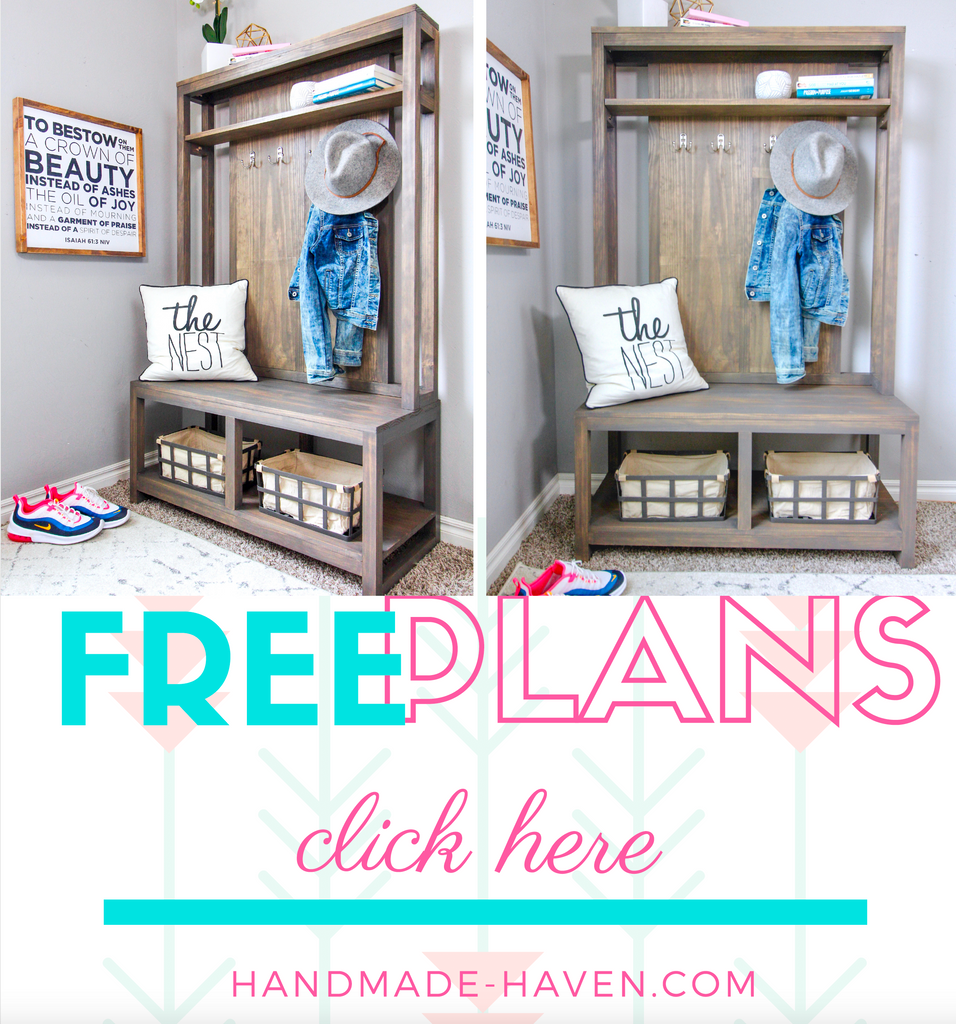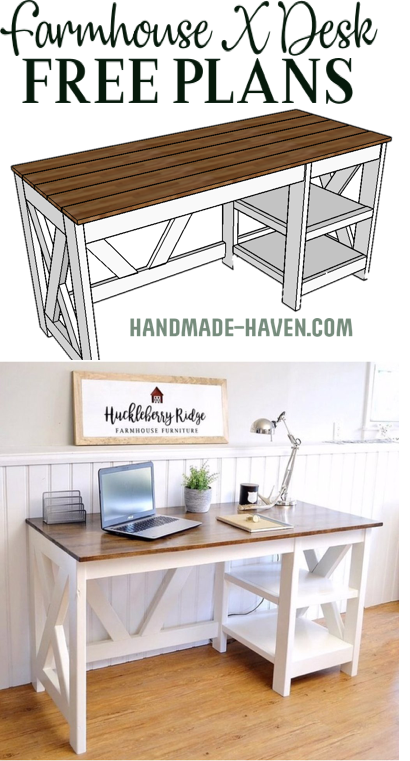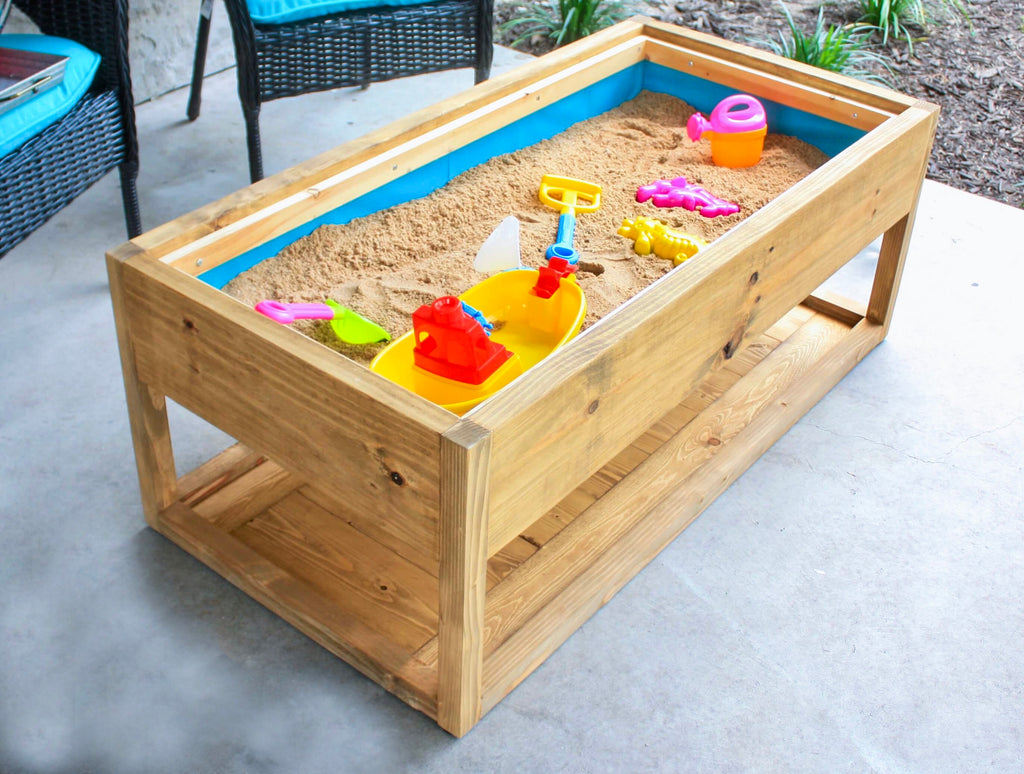Projects
Modern A-Frame Plant Stand
"Modernize your outdoor entryway with this fun A-Frame plant stand"
With the summer still going, I figured I would make a quick fun project for the outdoors. I am in love with all things modern these days, so I thought why not create a fun A-Frame plant stand.
"This post is sponsored by The Home Depot."

There are some affiliate links in this post, meaning I get a small commission if you purchase through these links, at no cost to you. Click Here to read my full disclosure.
Now let's get into the nitty gritty!
To complete this project you will need the following materials , mostly available at The Home Depot:
- 5 - 2 x 2 x 8ft
- 3 - 1 x 4 x 8ft
- 1 - 4ft x 8ft - 3/4" piece of plywood
- 1 - 1 x 2 scrap wood
- Golden Hinges
- Brad Nails
- Wood Glue
- 2 1/2" Pocket Hole Screws
- Varathane Golden Oak
- Folk Art Chalk Paint - Parisan Grey (alternative option)
Tools Used
Cut List
- 4 - 2x2s @ 36"
- 6 - 2x2s @ 30"
- 2 - 1x4s @ 12 3/4"
- 2 - 1x4s @ 29 1/2"
- 2 - 1x4s @ 20"
- 2- 1x4s @ 29 1/2"
- 1 - 3/4" piece of plywood @ 11.75" x 28.5"
- 1 - 3/4" piece of plywood @ 19" x 28.5"
Seeing instructions in writing isn't always helpful, so check out this video tutorial on how I built this Modern A-Frame Plant Stand before looking over the steps.
Step 1: Build the A-Frame for the Plant Stand
First I gathered all the wood I would need to build the frame of the plant stand and cut all of my wood down to size. I decided to use SELECT PINE wood for this build because it always gives a clean look.
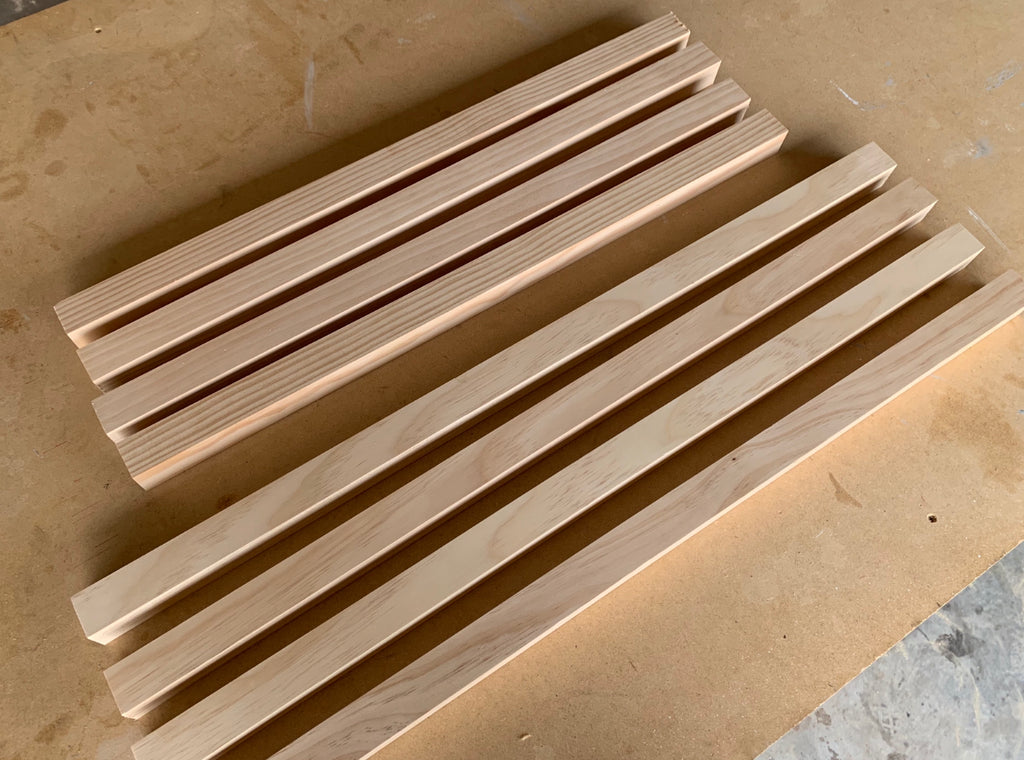
To attach the assembled sides together, I used a Kreg Jig on a 1 1/2" setting, with 2 1/2" pocket hole screws. I also used my Kreg Right Angle Clamp to assist with assembling the frame.
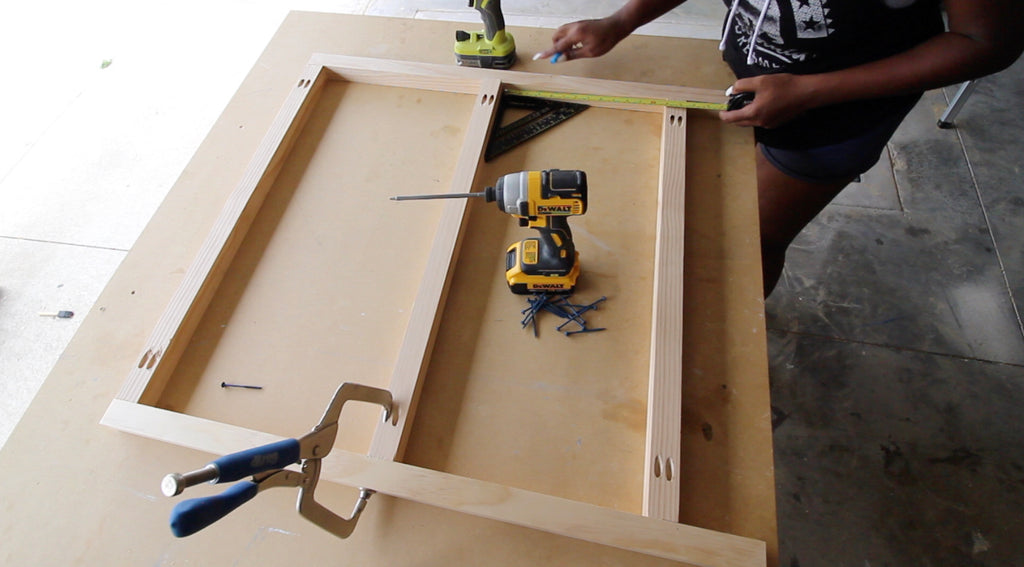
Once you have your two frame sides assembled, they should look similar to the picture below.
It is important to make sure these two pieces are as equal as possible, since this will be the main base for your plant stand.
Step 2: Add the Golden Hinges to the A-Frame Plant Stand
Now that the A-Frame is all assembled, it is time to add the Golden Hinges. I added one side of the hinges to one side of the plant stand frame first.
I placed the hinge down where I wanted it to be and made marks with a pen where the screws would drill into. I then drilled in some pilot holes using a 3/32" drill bit. This prevents wood from cracking and makes it easier to get the screws into place.
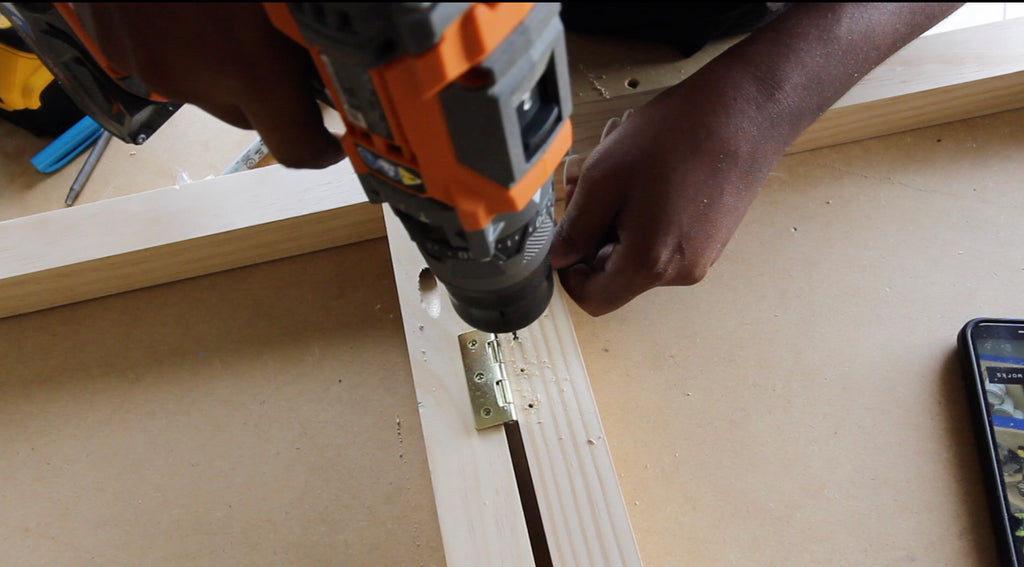
Then I used a screwdriver to screw in the screws. With small hardware like this, you want to stay away from power tools to prevent stripping a screw or messing up the project piece. Any screwdriver should suffice.
Once the hinges are in place, you should be able to spread the assembled pieces out to create an A-Frame.
Step 3: Build the Planter Boxes
Now with the A-Frame ready to go, the last step is building the planer boxes. First, I started cutting down my plywood with my Ridgid OCTANE Circular Saw.
This circular saw is said to be 30% more powerful than any it's previous versions and is industry leading 2-11/16 in. depth of cut and RIDGID is running a deal now that gives you an option of a free toll when you purchase a qualifying kit. Check it out here.
This saw also features an integrated chute with an included vacuum adaptor, which I thought was pretty cool. I really liked how smooth this circular saw cut through the plywood. Doubled with the RIDIGD Octane battery, this saw cut like a breeze.
Once the plywood was cut all down, I started building the boxes by attaching the 1x4s to the plywood with wood glue and brad nails. I used my brad nailer to secure the 1x4s into place.
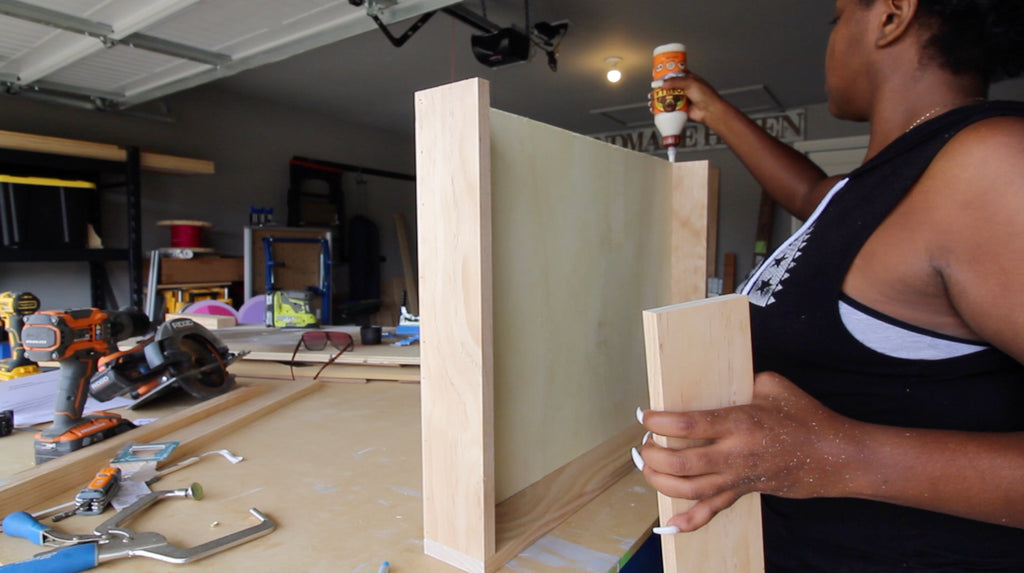
If you want your plant stand to be a little more sturdy , I would recommend using pocket holes or screws to assemble the boxes, but I opted for the quickest way.
Step 4: Paint/Stain the A-Frame Plant Stand
I decided to go with paint and stain for the A-Frame Plant Stand. For the stain I used, Golden Oak and I wanted the planter boxes to kind of look like concrete so I decided to finish the planter boxes in Folk Art Chalk Paint in Parisan Grey.
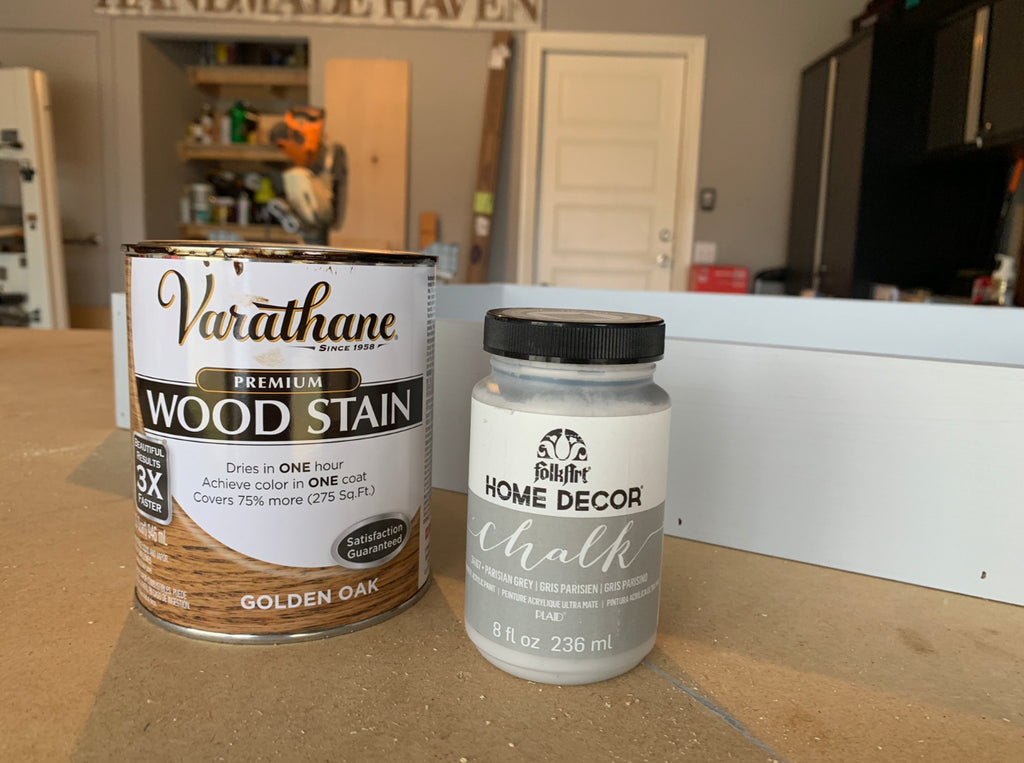
Now because this is an outdoor build, I'm not sure how well the chalk paint would hold up, but luckily my front entrance is covered, so it gets covered from a lot of weather. If you are building this for somewhere outside your house that isn't covered, I would recommend a more durable option for paint.
Let's take another look at this beauty. Isn't she lovely?
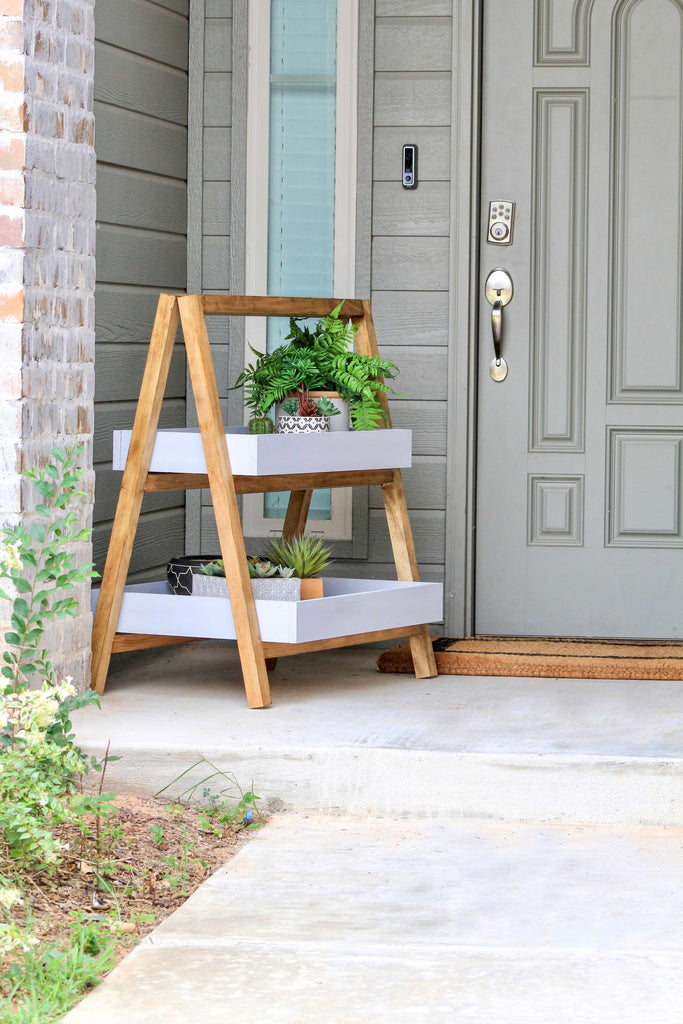
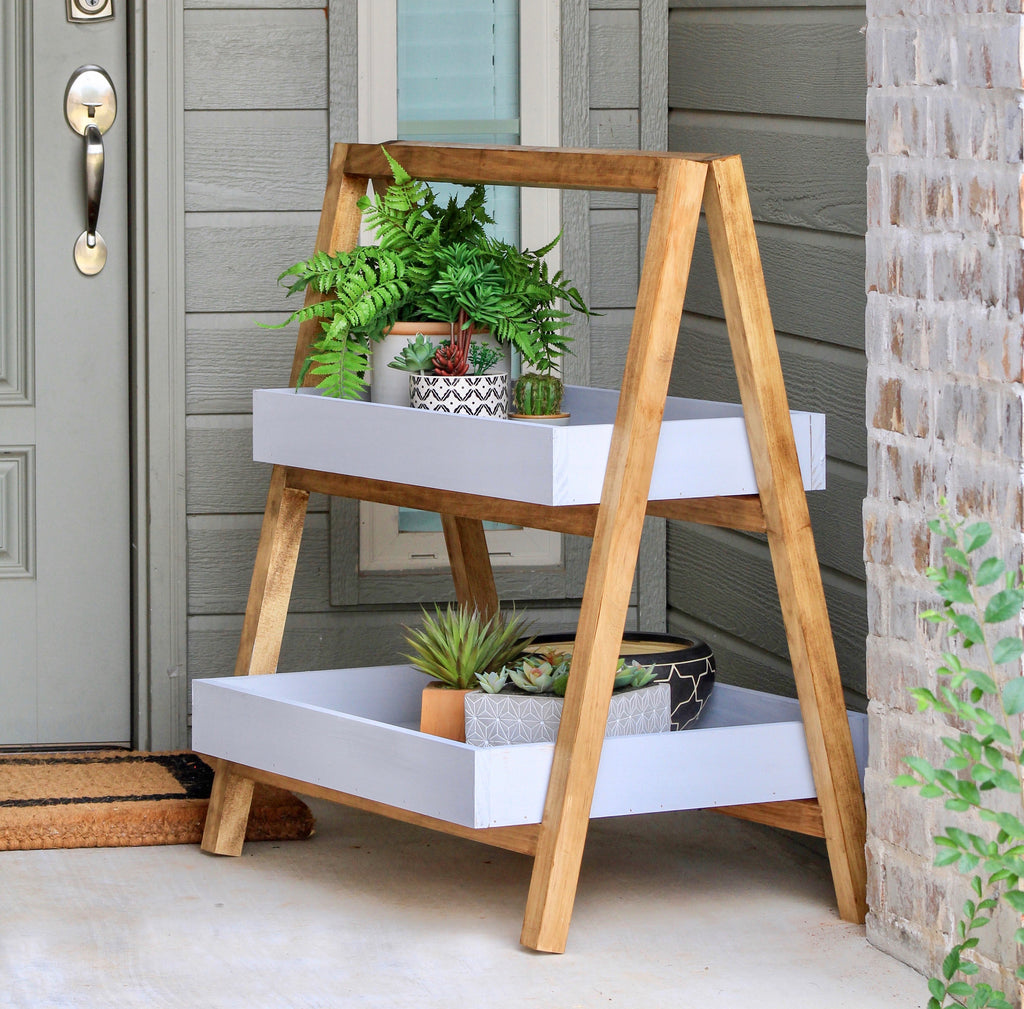

Thanks for reading guys, XOXO Ashley
DIY Hanging Wall Planter
“Who says plants can’t hang out in style?”
Hey guys! Angela here with Rustedpetal_ltd, here guest posting on the Handmade Haven blog. I am here and ready to walk you through how I made this Hanging Wall Planter. I had a blank space on the wall just outside of our deck doors that was screaming for something big and bold.
 After hours on Pinterest I saw several similar succulent wall hangers and knew this was the perfect project for my deck.
After hours on Pinterest I saw several similar succulent wall hangers and knew this was the perfect project for my deck.
Being up in Canada does pose a few challenges in trying to build similar items, as we don’t always have the same products available for purchase or the same growing window. (Though I wish we did)

But with a few tweaks, I was able to come up with this beauty which is absolutely perfect in our space. Let’s check it out!
There are some affiliate links in this post, meaning I get a small commission if you purchase through these links, at no cost to you. Click Hereto read my full disclosure.
Materials:
- 8 - Pine Tongue and Groove - 5”x8’ (you will need 8 boards)
- 4 – 1 x 2 x 8’
- 3 – 1 x 3 x 8’
- 9 - 6” Clay Pots
- Adjustable Pot Rings
- Wood glue
- Brad Nailer
- White Spray Paint
- White Exterior Paint
- Brad Nails
* Most cuts are best made on the go to allow for minor variations in the wood *
Cut list:
- 8 - Tongue and groove @ 36”
- 1 - 1x 2 @ 33 ¼”
- 2 - 1x 2 @ 39 3/4”
- 4 - 1x 2 @ 35 3/4”
- 1 – 1x3 @ 33 1/4”
- 2 – 1x3 @ 41”
- 2 – 1x3 @ 36”
Step 1: Cut Boards to Size
Cut your tongue and groove boards down to the necessary size. You will need 8 pieces cut at 36”
 Step 2: Assemble Wall Planter Backing
Step 2: Assemble Wall Planter Backing
Fit the tongue and groove together sliding the tongue into the groove, as shown below.
 Before attaching the bottom piece of tongue and groove, I ripped off the tongue on the table saw. (This can also be done with a circular saw, if you don’t have access to a table saw.)
Before attaching the bottom piece of tongue and groove, I ripped off the tongue on the table saw. (This can also be done with a circular saw, if you don’t have access to a table saw.)
 Now flip the boards over so the back is facing up and take the 3 - 1x2 pieces and attach them to the back of the tongue and groove with a bead of wood glue and 1”brad nails and your brad nailer.
Now flip the boards over so the back is facing up and take the 3 - 1x2 pieces and attach them to the back of the tongue and groove with a bead of wood glue and 1”brad nails and your brad nailer.
 This creates a frame around the hanging planter on the back and along the sides and the bottom. You will finish the framing on the back with the 1”x3” piece on the top.
This creates a frame around the hanging planter on the back and along the sides and the bottom. You will finish the framing on the back with the 1”x3” piece on the top. Now the back has a frame to hold everything together.
Now the back has a frame to hold everything together.
Step 5: Add Frame to Hanging Wall Planter
Cut the 1x3 for the exterior frame and flip the tongue and groove right side up. Attach the frame pieces to the sides of the hanger using a bead of wood glue and 1 1/4” brad nails. When you have the border on, you will want to flip the hanger over and attach the 4 pieces of 1x2 boards (35 3/4”). They will go at 7 1/2”, 11 1/4”, 20 1/2” and 25” from the left. This is mainly an aesthetic step as the screws for the hanger will go through the tongue and groove and poke out the back.
When you have the border on, you will want to flip the hanger over and attach the 4 pieces of 1x2 boards (35 3/4”). They will go at 7 1/2”, 11 1/4”, 20 1/2” and 25” from the left. This is mainly an aesthetic step as the screws for the hanger will go through the tongue and groove and poke out the back.
Step 7: Paint the Hanging Wall Planter
Now you are ready for paint or stain if you so choose.
 I used a pure white exterior paint to make sure the paint on the hanging planter would last throughout the seasons.
I used a pure white exterior paint to make sure the paint on the hanging planter would last throughout the seasons.
Step 8: Paint Clay Pots
While the hanger is drying, you can grab your 6” pots and spray paint them white. For this particular project, you will need nine of them. I used Rust-Oleum painters Touch 2X ultra cover paint and primer. With paint and primer in one, it really gives the clay pots plenty of coverage.
I used Rust-Oleum painters Touch 2X ultra cover paint and primer. With paint and primer in one, it really gives the clay pots plenty of coverage.
Step 9: Attach Plant Rings
Now you can attach the plant rings. They are spaced out 5 1/2” down from the top, 12’ in between the two sets and the bottom is 7 1/2’ up from the bottom.
Once the pots are all dry, add your pots and you are ready to plant! Now pick a spot on your wall, attach your hanging wall planter and and WAAA-LAAAH you are finished!
Now pick a spot on your wall, attach your hanging wall planter and and WAAA-LAAAH you are finished!

Now let’s take another look at this beauty! I used a heavy duty d-ring to hang it to my wall and it works like a charm.
Pick your plants and herbs and have fun! Thanks for reading guys!
Kid's Modern Play Kitchen Hack
"A play kitchen hack that will have you reconsidering your kitchen design"
It's not often that I get to work on projects for kids, so I knew this would be a fun project to tackle and I am over the moon with how this play kitchen hack turned out. This project had me reconsidering my own kitchen design, I mean just look at it.
"This post is sponsored by the Home Depot"
 Now just wait until you see what it looked like before the transformation. I promise you will love it that much more once you see the before photo, here it is.
Now just wait until you see what it looked like before the transformation. I promise you will love it that much more once you see the before photo, here it is.
There are some affiliate links in this post, meaning I get a small commission if you purchase through these links, at no cost to you. Click Here to read my full disclosure.
 Now this little play kitchen was cute, but I knew I could bring a little more pizzaz to it and the best part is that I did this transformation using mostly only spray paint. That's right! I was able to transform this Kid's Modern Play Kitchen in one day using Rustoleum Spray Paint. As you can see it did not disappoint.
Now this little play kitchen was cute, but I knew I could bring a little more pizzaz to it and the best part is that I did this transformation using mostly only spray paint. That's right! I was able to transform this Kid's Modern Play Kitchen in one day using Rustoleum Spray Paint. As you can see it did not disappoint.

The main colors I used for this DIY Kid's Play Kitchen were Rustoleum Deep Forest, which is hands down my new favorite color, Rustoleum Smokey Beige, which is more of a neutral color, Rustoleum Satin Bronze and Rustoleum black for the bottom of the Kid's play kitchen.
This combination of colors really made this play kitchen hack come to life. Now let's dive into how I tackled this DIY Kid's Play Kitchen Hack.
To complete this project you will need the following materials , all available at The Home Depot:
- Kids Play Kitchen
- Rustoleum Comfort Grip
- Painters Tape
- Foam Brush
- Dremel Go Screwdriver
- Decorative Wallpaper
- 1/4" sheet of plywood - 11.5" x 23.5"
- 3M Adhesive
- Brad Nail Gun
- 5/8" Brad Nails
- Craft Scissors
- Miter Saw
The colors I used:
- Rustoleum Spray Paint - Deep Forest
- Rustoleum Spray Paint - Satin Bronze
- Rustoleum Spray Paint - Smokey Beige
- Rustoleum Spray Paint - Satin Black
- Rustoleum Chalk Paint -Charcoal
Step 1: Remove Handles and Hardware
The fist thing I did to complete my Kid Play Kitchen was removing all of then handles and hardware. I used the Rustoleum Spray Paint - Satin Bronze to coat all of the handles and metal kitchen pieces.

Step 2: Tape off Kid's Play Kitchen
It would have been way easier to paint the pieces of the Kids Play Kitchen before putting it together but unfortunately this kitchen was already assembled, so I used painters tape to tape off the play kitchen, so I could begin spray painting the rest of the play set.
I also used some trash bags to help cover the Play Kitchen to eliminate using so much tape, this makes the process much easier.
Step 3: Spray Paint Play Kitchen
Once I had the play kitchen taped off, I begin spray painting. I used the Rustoleum Spray Paint - Deep Forest for the outer part of the Kid's Play Kitchen and this is when I feel in love with the color. The satin gloss made it really shine.

Now I have to share one of my favorite tools to use while using spray paint. The Rustoleum Comfort Grip makes spray paint projects a whole lot easier and less painless. The normal spray paint tops can make spray painting unbearable sometimes because continuously pressing the spray paint top can sometimes cause hand cramps, but the attachment makes spray painting easy.

The bottom of the play kitchen was coated in Rustoleum Spray Paint - Satin Black and it really made the modern legs on the Kids Play Kitchen look great.
Step 4: Reattach Hardware and Handles
After waiting about an hour or so, the spray paint was dry enough to touch so I began adding the handles and hardware back not he Kid's Play kitchen. I didn't use any big power tools on this play kitchen because its so fragile, instead I used my Dremel Go Screwdriver to add the hardware back on.
Step 5: Add Backsplash
The play kitchen already started to look great but /I knew some added backsplash would be the one additive to take this Kid's Play Kitchen to the next level. After looking through a few wallpaper designs, I decided on this black and white Decorative Wallpaper. I knew it would contract really well with the Deep Forest and I was right.
To add the backsplash I took a 1/4" sheet of plywood and cut it down to a 11.5" x 23.5" piece using my miter saw. I then cut down the wallpaper using my craft scissors enough so that the wallpaper was slightly longer than the 1/4" plywood piece. To secure the wallpaper to the plywood I used 3M Adhesive.
I secured the plywood backsplash piece to the play kitchen using my brad nail gun and 5/8" brad nails. Then I cut out two little small squares to go into the top of the Kid's Play kitchen and used the 3M adhesive to secure that as well.
Step 6: Paint Over the Play Kitchen Stove
After adding the backsplash, I could see the end in sight. The last thing to do was to paint over the play kitchens stove. It had some pink in it so I wanted to cover it up to match the rest of the play kitchen.

While waiting for the chalk paint to dry, I began admiring all of the colors. It turned out way better than I imagined.
Now let's take another look at the final transformation.
 I couldn't be happier with how this transformation came out. It's amazing what you can do with a little bit of spray paint. It looks like a big transformation but it was fairly easy, something /I'm sure anyone can tackle.
I couldn't be happier with how this transformation came out. It's amazing what you can do with a little bit of spray paint. It looks like a big transformation but it was fairly easy, something /I'm sure anyone can tackle.
 The Decorative Wallpaper definitely made this Kid's Play Kitchen seem realistic. This color scheme would be a great color scheme for a real kitchen. This kitchen playset is making me want to be a kid again.
The Decorative Wallpaper definitely made this Kid's Play Kitchen seem realistic. This color scheme would be a great color scheme for a real kitchen. This kitchen playset is making me want to be a kid again.
 I think it's safe to say that everyone loves a good before and after and this is definitely a before and after to remember.
I think it's safe to say that everyone loves a good before and after and this is definitely a before and after to remember.

Be sure to check out the Rustoleum Color Palette to see the tons of spray paint options that Rustoleum has to offer and I have great news, Home Depot is partnering with me to give away two $50 gift cards to two lucky readers. Enter below for a chance to win.
a Rafflecopter giveawayThanks for reading guys! XOXO, Ashley
Office Shelf Organizer and Message Board
"This office shelf organizer and DIY message board is sure to get your desk back in order"
I am excited to be joining forces with a cool group of bloggers to bring you a fun project for a fun DIY monthly challenge. This month, we were challenged to make something awesome out of a single 8-foot board and today I am excited to show you what I've come up with; a DIY office shelf organizer and message board.
"This post is sponsored by the Home Depot"
 I had two projects in mind and couldn't decide between the two, so I decided to do both! HOORAY! Not only did I create this cool office shelf organizer, but I also created this fun DIY Message Board to go along with it. You never can have enough organization in the office right?
I had two projects in mind and couldn't decide between the two, so I decided to do both! HOORAY! Not only did I create this cool office shelf organizer, but I also created this fun DIY Message Board to go along with it. You never can have enough organization in the office right?
There are some affiliate links in this post, meaning I get a small commission if you purchase through these links, at no cost to you. Click Here to read my full disclosure.
Now let's get to it!
Office Shelf Organizer
Let's get started with the Office Shelf Organizer first. This project was quick and easy and only required, guess what...ONE BOARD! Shocker right? For this project, I used a 1x10x8 Select Pine Board.
Step 1: Cut Wood to Size
The first thing I did for the Office Shelf organizer was cutting the wood down to the specified measurements. I used my miter saw to cut down the 1x10 down.
You will need the whole entire board for this project, so make your cuts accurately. Here are the measurements I used for the shelf organizer.

Step 2: Drill Pocket Holes
Once the wood was cut down to size, I began drilling pocket holes in the wood using my Kreg Jig. I drilled the pocket holes into the three 15" pieces on a 3/4" setting.

Step 3: Assemble Right Side of Shelf Organizer
For the right side of the organizer, I first attached a 15" piece to the 9" piece with my drill using 1 1/4" pocket hole screws and wood glue. Then you will attach the other side of the 15" piece to the 18" piece. This piece should be drilled 8.75" up the 18" board.

Step 4: Assemble Left Side of Shelf Organizer
To assemble the right side of the office shelf organizer, first attach the two remaining 15" pieces to the 6" piece using 1 1/4" pocket hole screws and wood glue
Once the two 15" boards are attached, attach the assembled side to the remaining 18" piece using 1 1/4" pocket hole screws and wood glue. It should be drilled 9" up the 18" board. Now you have two assembled pieces that will make up your office shelf organizer.
DIY Message Board
Next up, the DIY Message Board. I was able to have a little more fun with this one, but still was constrained to using one board. For this project, I used one 1x4x8 board.

Step 1: Cut Wood To Size
First, I cut the wood down to size. Here are the measurements you'll need.

Step 2: Assemble Message Board Frame
Once the wood is cut down, pre- drill pocket holes into the two 17" wood pieces, using a Kreg Jig on a 3/4" setting. Then assemble the frame using 1 1/4" pocket hole screws and wood glue
 I used my Kreg Right Angle Clamp, to help me screw the sides together. This helps keep everything nice and tight while you're screwing the sides together.
I used my Kreg Right Angle Clamp, to help me screw the sides together. This helps keep everything nice and tight while you're screwing the sides together.
Step 3: Stain/Paint Message Board Frame
Once the frame is assembled, stain the message board with the stain of your choice. I opted to go with Varathane Briarsmoke. I'm staining the wood underneath so that when I sand the edges after painting, the wood stain will show through.

Step 4: Attach Cane Webbing and Accesories
I've been seeing cane webbing popping up all over the place, so I thought it would be a good addition to my message board. I first had to cut down the webbing to make it fit behind the frame.
It was easy to cut with just a pair of craft scissors. Make sure to cut just enough to have enough webbing left on each corner to be able to staple it down to the message board. I then started attaching the cane webbing to the message board frame using my staple gun and air compressor. I began stapling down one side and then carefully stapled down each side, one by one.
I then started attaching the cane webbing to the message board frame using my staple gun and air compressor. I began stapling down one side and then carefully stapled down each side, one by one. 

After the cane webbing was attached, I used my Ryobi glue gun to add on these fun golden clips. I applied a small amount of hot glue and placed them on the bottom of the message board. Now can I just say how happy I was when I found out that Ryobi had a cordless hot glue gun. I hate having to plug hot glue guns in, so this tool was highly welcomed to my tool collection.
Now can I just say how happy I was when I found out that Ryobi had a cordless hot glue gun. I hate having to plug hot glue guns in, so this tool was highly welcomed to my tool collection.
I really love that it's self standing because in the past, Ive used hot glue glue where I had to lay it on its side and sometimes it got messy. It also features an On/Off LED Indicator, so you can turn it on and off when needed. This cordless glue gun screams professional.
Now, let's take another look at these cool Office Organizers. Between this office shelf organizer and DIY message board, I should have no problem keeping things in order; at least for now.
 I'm in love with how it came out and I am so glad I decided to go with both projects. If you are looking for a quick DIY to do with just one board, now you have two ideas to choose from.
I'm in love with how it came out and I am so glad I decided to go with both projects. If you are looking for a quick DIY to do with just one board, now you have two ideas to choose from.
Farmhouse Nightstand
"This farmhouse nightstand is giving DIY a new name"
I always love sharing new projects, and even more than that I love partnering with other great builders to present those projects, and today I get to partner up with Huckleberry Ridge Furniture for the second time and I'm super excited to show you why! 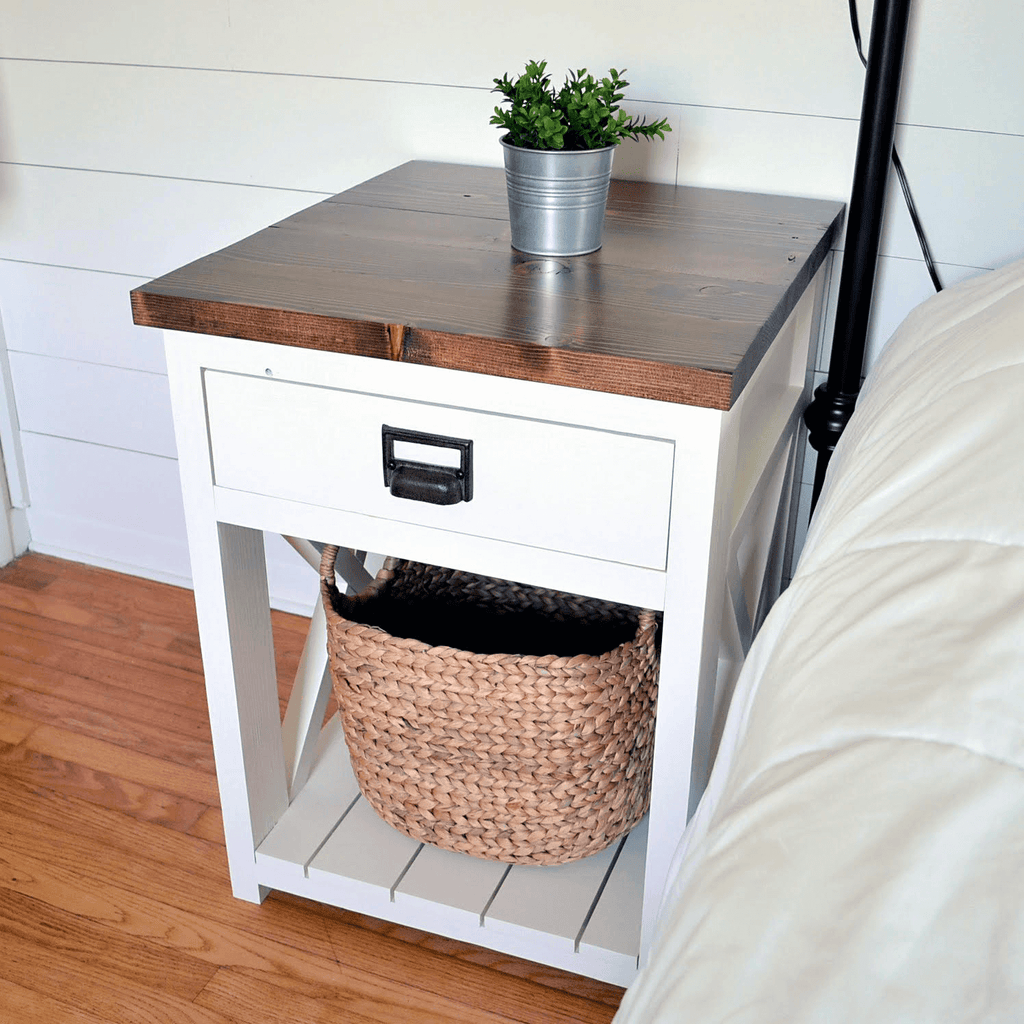 A while back we partnered together on the Farmhouse X Desk and it was a hit. I mean just look at it, why wouldn't it be? I completely fell in love with this desk and now I have something else to drool over.
A while back we partnered together on the Farmhouse X Desk and it was a hit. I mean just look at it, why wouldn't it be? I completely fell in love with this desk and now I have something else to drool over.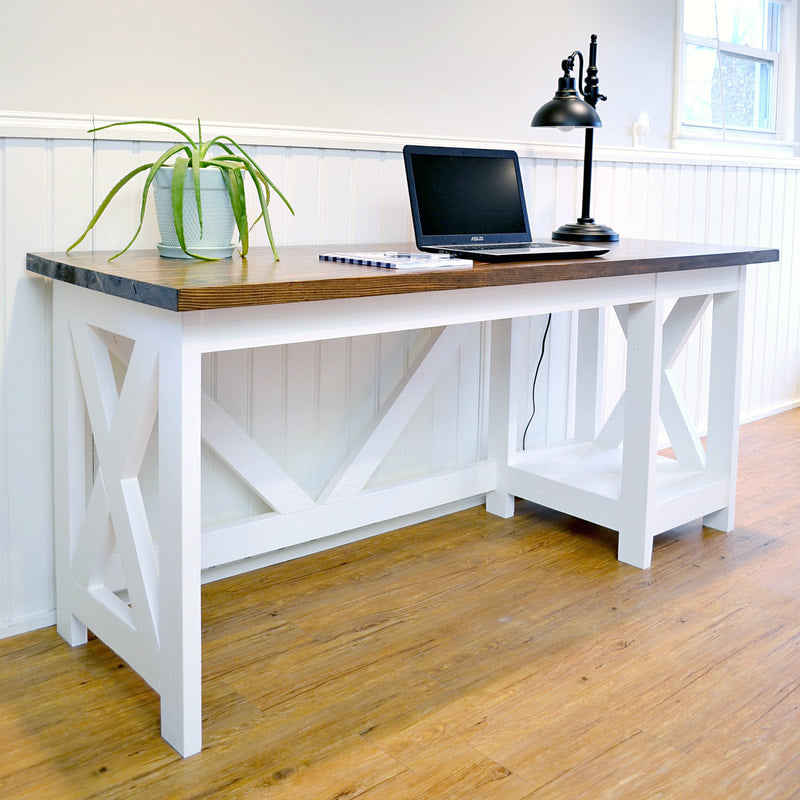 So we are back again, with a vengeance! Ok, maybe that was too much; but we are back again with another awesome 3D plan, a Farmhouse Nightstand; or side table, if you prefer, and we hope you enjoy! It's giving me Joanna Gaines Vibes.
So we are back again, with a vengeance! Ok, maybe that was too much; but we are back again with another awesome 3D plan, a Farmhouse Nightstand; or side table, if you prefer, and we hope you enjoy! It's giving me Joanna Gaines Vibes.
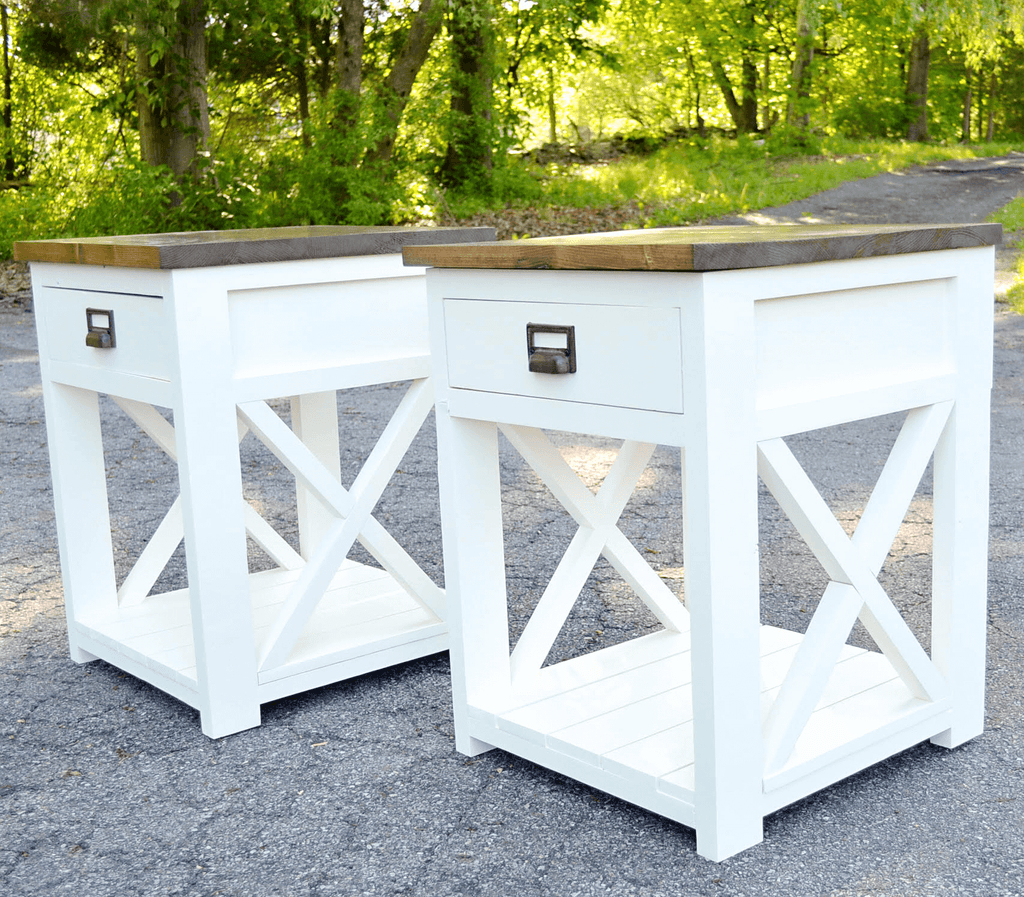
Be sure to go check these guys out on Instagram and Facebook to check out more of their great work after looking through these Farmhouse Nightstand plans.
There are some affiliate links in this post, meaning I get a small commission if you purchase through these links, at no cost to you. Click Here to read my full disclosure.
Dimensions
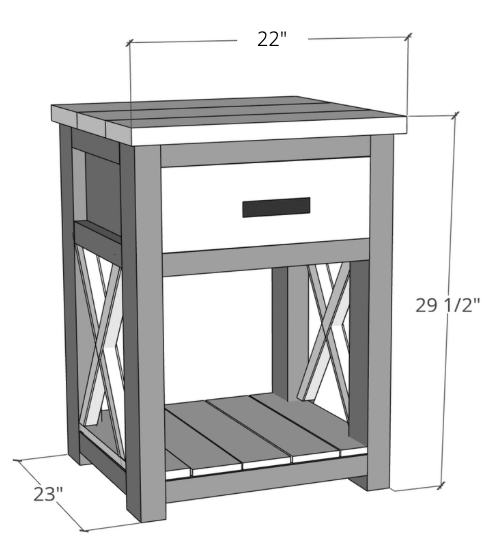
Materiels List
- 2 - 2 x 4 x 8 ft
- 3 - 1 x 2 x 8 ft
- 1 - 1 x 10 x 8 ft
- 2 - 2 x 6 x 8 ft
- 2 - 1 x 4 x 8 ft
- 1 - 1 x 6 x 8 ft
- 1 - 1/4" sheet of plywood - 2 x 2 ft
- 1 - 2 x 2 x 8 ft
See Printable Plans for Cut List
Now let's get to it.
Step 1: Build Farmhouse Nightstand Sides
First you will build the farmhouse nightstand legs by attaching the legs together with the stretcher pieces using a drill and Kreg Jig K4 Pocket Hole System. You will be using 1 1/4" Pocket Hole Screws to attach the pieces together. You will be repeating this step twice so that you have two side pieces for the farmhouse nightstand.

Next, you will attach the inside boards to the assembled side again using a drill and 1 1/4" Pocket Hole Screws to attach along with wood glue.

Pocket holes should be drilled on the sides of the 1x8 and drilled into the 2x4. Repeat this step for the other side of the farmhouse nightstand.
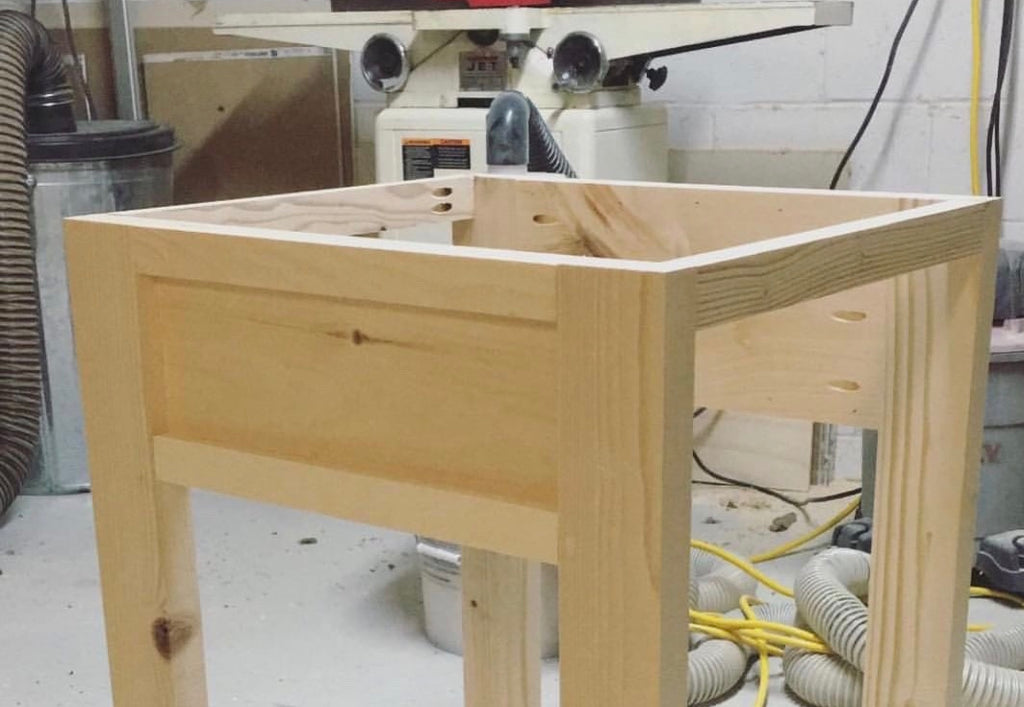
Step 2: Attach Farmhouse Nightstand Sides
Next, you will assemble the two farmhouse nightstand sides together using 1 1/4" Pocket Hole Screws to attach along with wood glue. It may be helpful to utilize a right angle clamp here to help secure the piece of wood while you are screwing in the pocket hole screws.

You will complete the assembly of the farmhouse nightstand by attaching the remainder stretcher pieces to the piece.
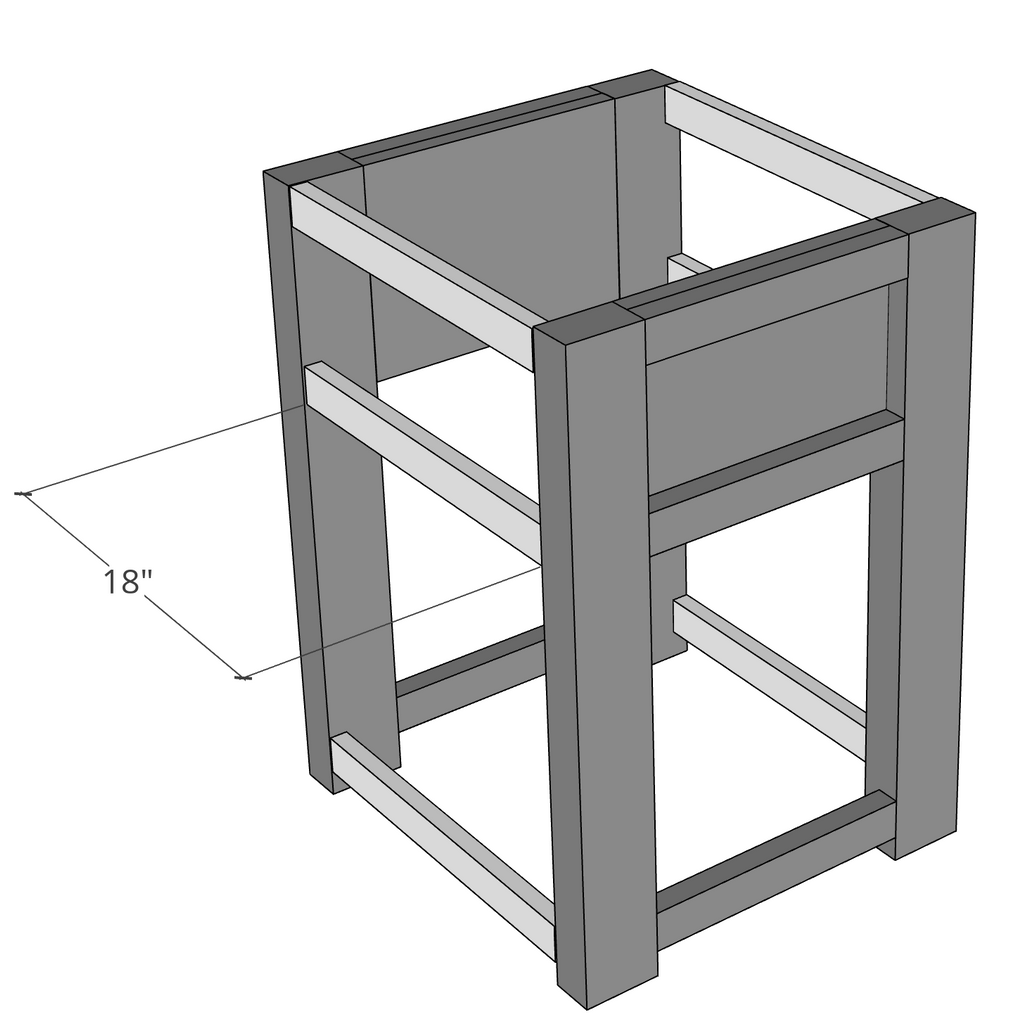
Step 3: Build the Inside of the Farmhouse Nightstand
Once the stretcher pieces are in place, you will attach the inner wood pieces of the nightstand to the assembled farmhouse nightstand again using a Kreg Jig and 1 1/4" Pocket Hole Screws.Your pocket holes should be drilled on the sides of the 1x8 and drilled into the 2x4.
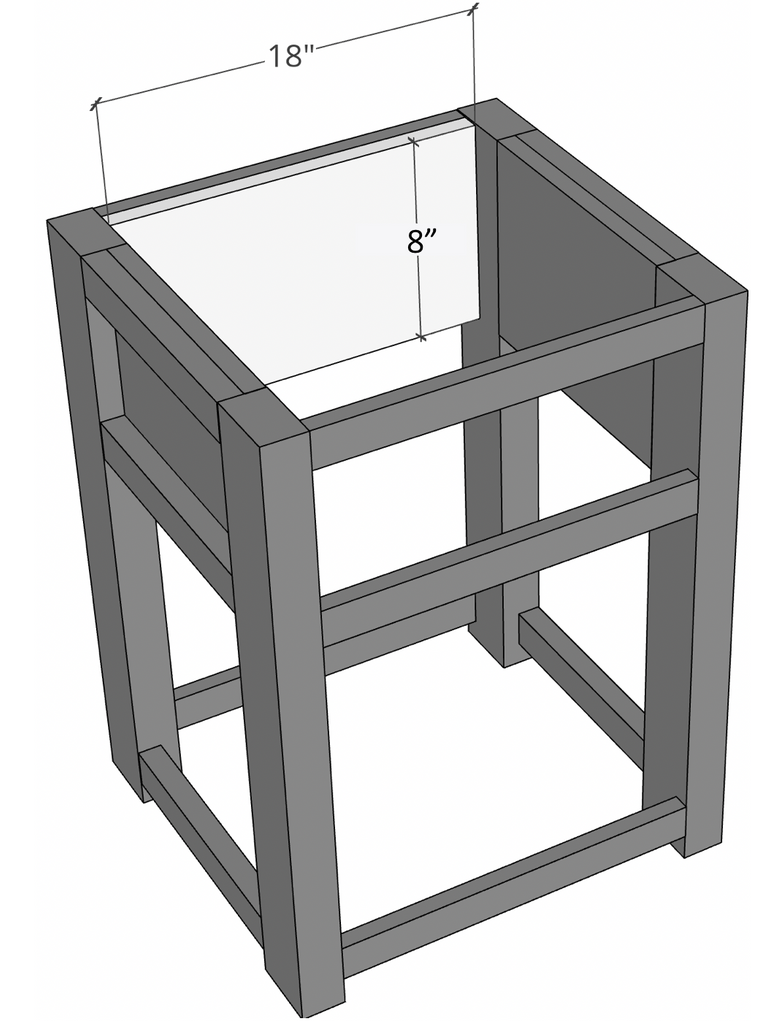
Now we will start adding the pieces that will hold the nightstand drawer. We will be attaching 1x2s to the insides of the nightstand. These 1x2s should be flush with the bottom of tops inside.. Then 1x2s will be attached to the left and right side of the farmhouse nightstand using wood glue and wood screws.
These 1x2s will serve as the supports for the drawer. If you'd rather use drawer slides, feel free to skip this step and adjust drawer size as needed.

Step 4: Attach Nightstand Bottom
Next, you will add the 1x4 boards to create the bottom of the farmhouse nightstand. When dealing with the outside corners of the nightstand, you will need to use your bandsaw or a jigsaw to notch out the corners of the left and right 1x4s and leave spacing in between each board for a planked look.

Place the 1x4s out before nailing them down. Spacing should approximately be about 7/8" between each board.
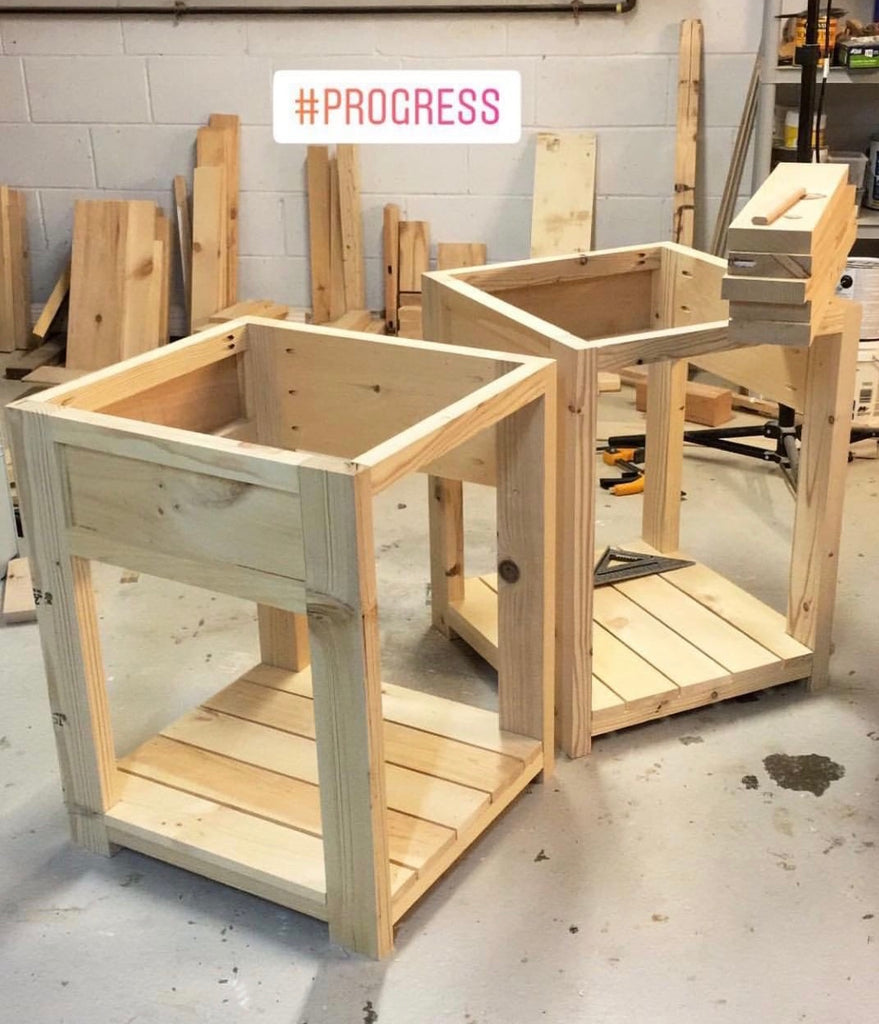
Step 5: Attach Nightstand Top
Once the nightstand base is all assembled, you will assemble the top of the farmhouse nightstand and attach it to the nightstand base using Tabletop Z clips fasteners or wood screws from the inside.
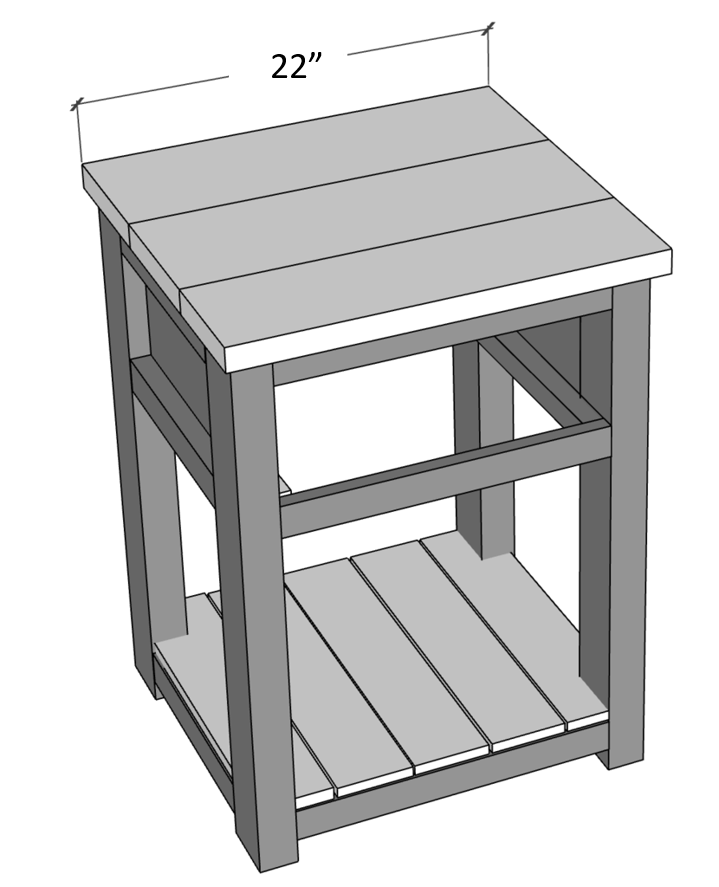
Step 6: Build Nightstand Drawers
You will begin assembling the drawers together using a Kreg Jig on a 1 1/2" setting, with 1 1/4" Pocket Hole Screws to attach along with wood glue. Utilize your right angle clamp, to clamp the boards into place while you drive in your pocket hole screws.
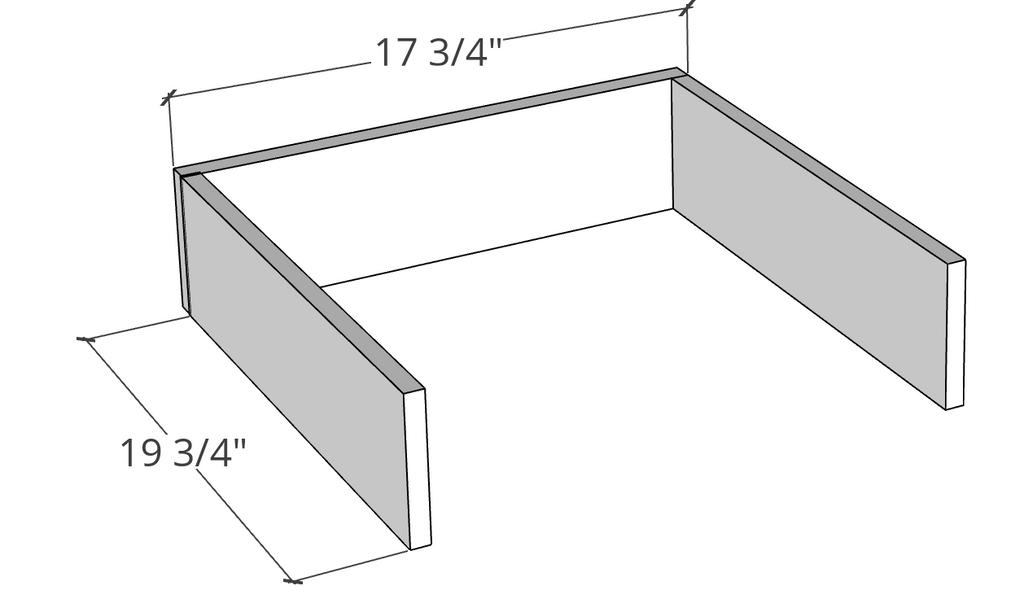
You will attach the 1/4" drawer bottom to the assembled drawer using a staple gun and 1" staples.

Next, you will attach the front of the drawer to the assembled box using the pre-drilled pocket holes. Once the drawer is assembled, it should slide right in on the 1x2s on the farmhouse nightstand. If you opt to use drawer slides, you will need to adjust the drawer slides accordingly.
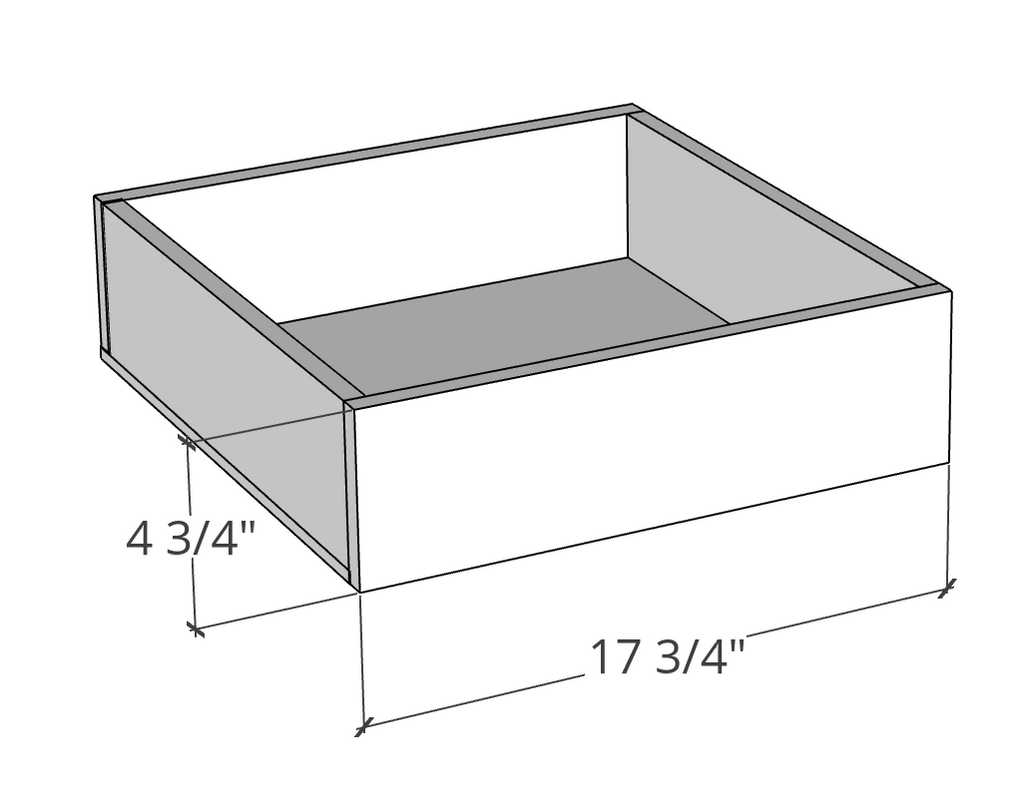
Step 7: Add Decorative Trim
Once the drawer is built, you will begin adding the 2x2 X braces to the nightstand. It may be wise to measure the 2x2s to your already assembled nightstand first before making cuts for the best fit. The measurements should serve as just a guide.

Now this is the fun part! Finish off your nightstand with the color of your choice! Michael and Sara used Walnut Stain with matte polycrylic for the top and "Creamy" by Sherwin Williams for the bottom and don't forget a cool drawer pull for the front drawer.
The Farmhouse nightstand should now be complete! I absolutely love this project and I hope you do too. Cant wait to see all of your attempts at this build.
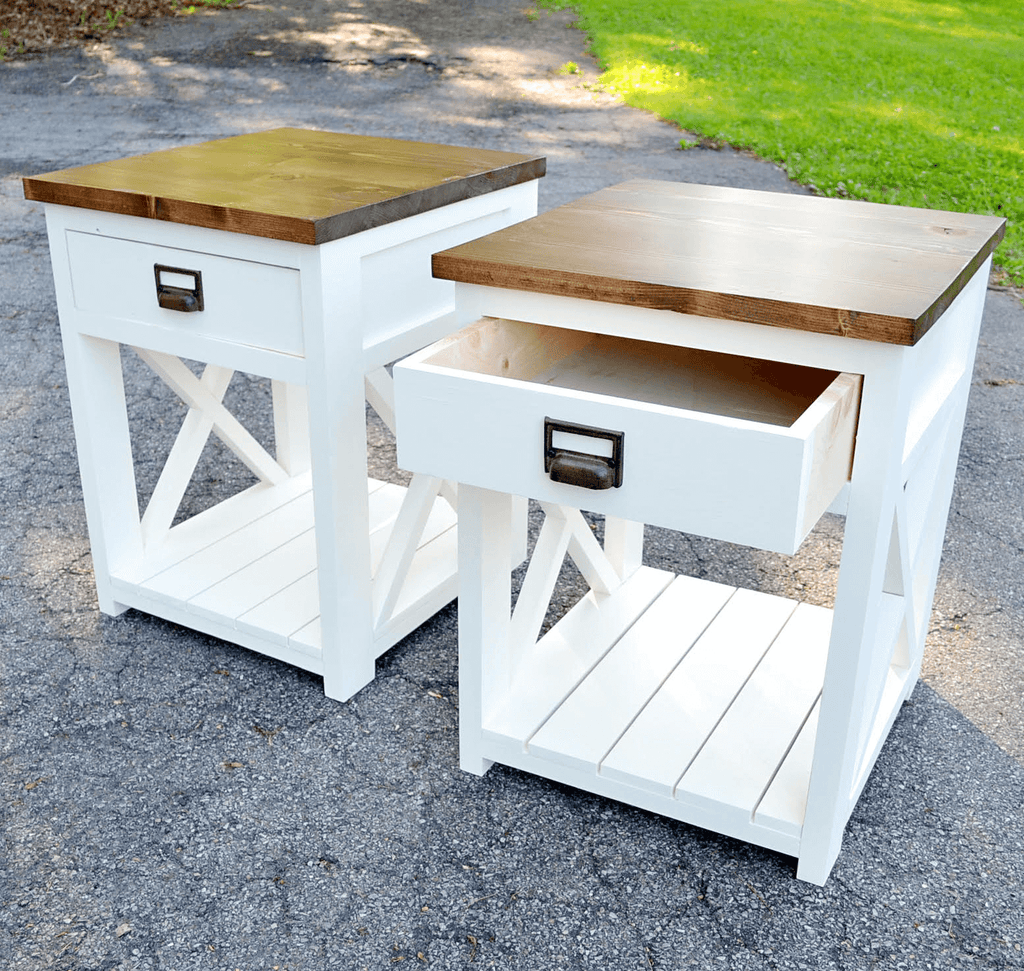 But I can't let you go without just one more look. Michael and Sara really knocked this out of the park. I hope you enjoyed these Farmhouse Nightstand plans, can't wait to see what you come up with.
But I can't let you go without just one more look. Michael and Sara really knocked this out of the park. I hope you enjoyed these Farmhouse Nightstand plans, can't wait to see what you come up with.
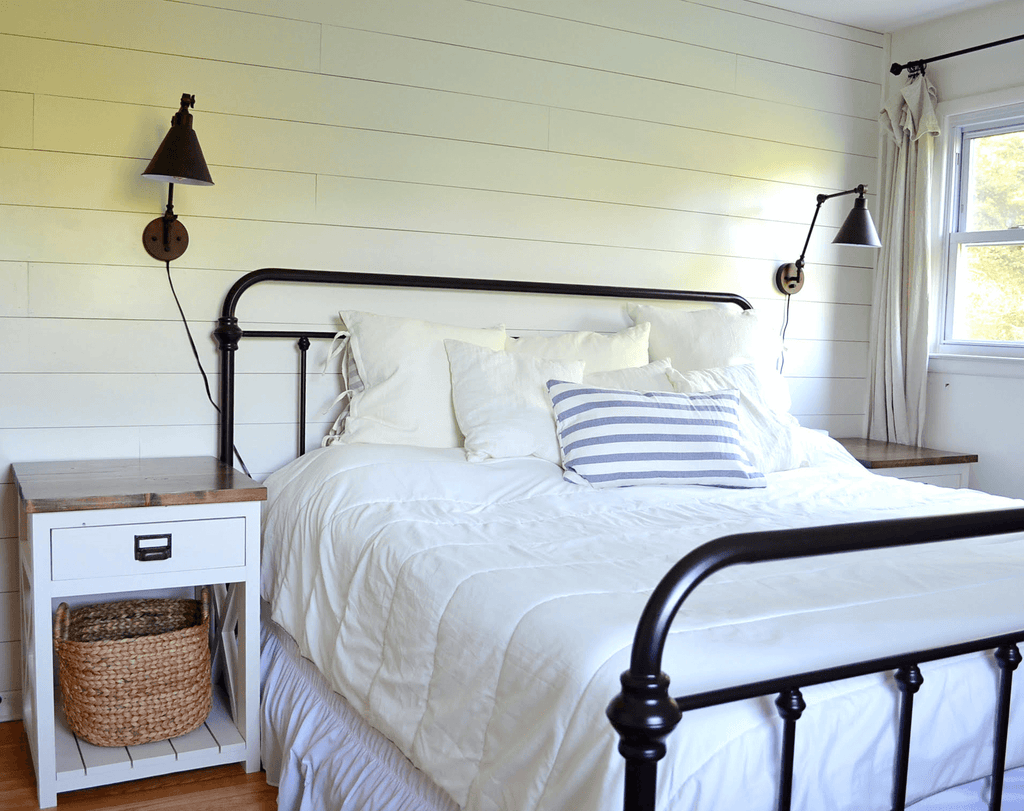
Thanks for reading guys, XOXO Ashley
DIY Leather Woven Headboard
"This DIY Leather Woven Headboard is giving me all the feels"
You can say that I've been bitten by the leather bug because I am all about these leather projects. This is my second leather project of the week and I am in love.
"This post is sponsored by The Home Depot."

I don't usually do headboards but I am so glad I decided to tackle this fun DIY because Im so satisfied with the way it came out. The best part was that this Leather Woven Headboard was only $80. Now you can't beat that.
 Last week I made a DIY Leather Woven Bench and it was the inspiration for this headboard and I'm not going to lie, I have a few other projects in mind with the same kind of technique. The measurements for this headboard are for a Queen Headboard, but you can add on or take away from the wooden frame to make it whatever size you'd like. Now let's get into it.
Last week I made a DIY Leather Woven Bench and it was the inspiration for this headboard and I'm not going to lie, I have a few other projects in mind with the same kind of technique. The measurements for this headboard are for a Queen Headboard, but you can add on or take away from the wooden frame to make it whatever size you'd like. Now let's get into it.
There are some affiliate links in this post, meaning I get a small commission if you purchase through these links, at no cost to you. Click Here to read my full disclosure.
Dimensions

Materiels
- 4 - 2x2s @ 6ft
Green Vinyl Fabric (4 Yards)
Ryobi 70 Piece Impact Driving Kit
Be sure to check out the how-to video before reading through the steps.
Step 1: Assemble The Bed Frame
The first step for the DIY Leather Woven Headboard was to first assemble the frame. I used four 2x2s to assemble the bed frame along with 2 1/2" pocket hole screws. To assist with the assembly, I used my Kreg Right Angle Clamp to get those pocket holes in. To make the headboard a little more sturdy, I decided to add corner braces to the four sides of the headboard.
To assist with the assembly, I used my Kreg Right Angle Clamp to get those pocket holes in. To make the headboard a little more sturdy, I decided to add corner braces to the four sides of the headboard. To help me drill in the corner braces, I used a Philip head bit from my Ryobi 70 Piece Impact Driving Kit. It includes impact rated bits with hex shank for impact drivers and drills and includes a magnetic screw guide, nut drivers and socket adaptors.
To help me drill in the corner braces, I used a Philip head bit from my Ryobi 70 Piece Impact Driving Kit. It includes impact rated bits with hex shank for impact drivers and drills and includes a magnetic screw guide, nut drivers and socket adaptors.
Step 2: Apply the Vinyl to the Headboard Frame
 I first began marking the lines on my vinyl fabric by using a 2x2 and a fine point sharpie. If you want to make your leather strips bigger just make sure you mark them evenly.
I first began marking the lines on my vinyl fabric by using a 2x2 and a fine point sharpie. If you want to make your leather strips bigger just make sure you mark them evenly. Once the strips were marked, I began cutting the fabric strips using my craft scissors. Any good pair of scissors should work here. The vinyl fabric was really easy to cut through.
Once the strips were marked, I began cutting the fabric strips using my craft scissors. Any good pair of scissors should work here. The vinyl fabric was really easy to cut through.
 Then I begin attaching the leather strips, one by one, to one side of the bed frame. I attached the strips using my Staple Gun and used one of the corner braces as a way to measure the spacing between the leather strips.
Then I begin attaching the leather strips, one by one, to one side of the bed frame. I attached the strips using my Staple Gun and used one of the corner braces as a way to measure the spacing between the leather strips. Once one side is secured down, pull the leather strip to the other side with a good snug and secure it down into place with your Staple Gun. It should look like this when you're done.
Once one side is secured down, pull the leather strip to the other side with a good snug and secure it down into place with your Staple Gun. It should look like this when you're done. Once one full side was secured down, I began securing down the leather strips on the top of the headboard, using my staple gun
Once one full side was secured down, I began securing down the leather strips on the top of the headboard, using my staple gun Once the top leather strips are secured down on the DIY leather headboard, you can begin weaving the leather strips through the secured strips, alternating each weave one by one. As you can see, this was the fun part because I was having way too much fun.
Once the top leather strips are secured down on the DIY leather headboard, you can begin weaving the leather strips through the secured strips, alternating each weave one by one. As you can see, this was the fun part because I was having way too much fun.

 Once you attach the strips, your DIY headboard is finished! and it looks pretty darn good.
Once you attach the strips, your DIY headboard is finished! and it looks pretty darn good. I can't be any happier with how this DIY Leather Woven Headboard turned out. I am now questioning whether or not I need one for my bedroom and let's not forget that this headboard was only $80. Now that takes the cake. Let's take another look at how it came out.
I can't be any happier with how this DIY Leather Woven Headboard turned out. I am now questioning whether or not I need one for my bedroom and let's not forget that this headboard was only $80. Now that takes the cake. Let's take another look at how it came out. I am so glad I opted to go with the green, instead of the regular brown color, it gives this space so much contrast, and the green looks lovely against that natural wood.
I am so glad I opted to go with the green, instead of the regular brown color, it gives this space so much contrast, and the green looks lovely against that natural wood.

 The weave pattern is just out of this world. I hope you enjoyed this project and I can't wait to see you try it out.
The weave pattern is just out of this world. I hope you enjoyed this project and I can't wait to see you try it out.


DIY Leather Woven Bench
"Who knew a DIY Leather Bench could look so trendy"
I am seeing leather benches everywhere, so they must be the hot new thing right now, so I figured I'd jump on the bandwagon and create my own DIY Leather Bench.
"This post is sponsored by the Home Depot" I wanted to take it a step further and give it a little pizzaz, so I decided to do a woven technique on the bench top, so now I have this cool DIY Leather Woven Bench and I'm so excited to finally share it with you guys.
I wanted to take it a step further and give it a little pizzaz, so I decided to do a woven technique on the bench top, so now I have this cool DIY Leather Woven Bench and I'm so excited to finally share it with you guys. The best part is, I am bringing you the full tutorial and build video today so you can recreate your own. I mean this project is just too good to keep to myself. So let's get to it!.
The best part is, I am bringing you the full tutorial and build video today so you can recreate your own. I mean this project is just too good to keep to myself. So let's get to it!.
There are some affiliate links in this post, meaning I get a small commission if you purchase through these links, at no cost to you. Click Here to read my full disclosure.
Dimensions

Materiels/Tools
Bench
7 - 2x2s@ 6ft (Select Pine)
2 1/2" Pocket Hole Screws
Bench Cut List
4 - 2x2s @ 48 1/4"
12 - 2x2s @ 13 1/2"
Bench Top
1 - Project Panel (16x48)
PolyFoam ( 2x27x76)
1 Yard - Black Fabric
2 Yards - “Leather” Fabric (I used vinyl-Spot Cinnamon Whisper)
Craft Scissors
With a project like this, I know it's much easier to follow along with a video, so I made sure to catch this process on camera to help make it easier on you guys. Enjoy!
Step 1: Assemble the Base
I used my handy dandy Kreg jig to create all of the pocket holes, along with my RIDGID Drill Driver, Industry Leading with 1,300 in.-lbs. of Torque and it comes along with an Impact driver. The better part is when you by the Drill and Impact Driver Kit, you get two tools free, know who wouldn't want that?
To help assemble the base, I used my Kreg right angle clamp and Ridgid Drill and Impact Driver. The Kreg Right Angle clamp really comes in handy while building because it sort of serves as a second hand.
 The Ridgid Impact Driver is the industry's leading with 2,400 in.-lbs. of torque; and it features three speeds and three specialty modes for versatility. These two tools made making this base a breeze.
The Ridgid Impact Driver is the industry's leading with 2,400 in.-lbs. of torque; and it features three speeds and three specialty modes for versatility. These two tools made making this base a breeze.
 Begin assembling the base by attaching the (48 1/4") 2x2s to the (13 1/2") 2x2s using a Kreg Jig on a 1 1/2" setting, with 2 1/2" 2 1/2" pocket hole screws to attach along with wood glue. Use your Kreg Right Angle Clamp to assist.
Begin assembling the base by attaching the (48 1/4") 2x2s to the (13 1/2") 2x2s using a Kreg Jig on a 1 1/2" setting, with 2 1/2" 2 1/2" pocket hole screws to attach along with wood glue. Use your Kreg Right Angle Clamp to assist.

Attach the two middle (13 1/2") 2x2 to the assembled side using a Kreg Jig on a 1 1/2" setting, with 2 1/2" pocket hole screws to attach along with wood glue. and repeat both steps to create two bench base sides. Use your Kreg Right Angle Clamp to assist.

Attach the two assembled base sides together with the four remaining (13 1/2") 2x2s using a Kreg Jig on a 1 1/2" setting, with 2 1/2" pocket hole screws to attach along with wood glue. Use your Kreg Right Angle Clamp to assist.

The bench base should look something like this when you are complete.

If you want a cleaner look, go back through and fill all of the visible pocket holes in the back. For help on how to easily fill pocket holes, check out my technique here.
Step 2: Create the Leather Woven Bench Top
Cut the polyfill down to the size of the project panel. You should cut about a 1/2" around the project panel using craft scissors or tool of your choice. Once the polyfill is cut, take your spray adhesive and spray the foam all over one side and attach it to the wooden project panel piece.
Once the polyfill is cut, take your spray adhesive and spray the foam all over one side and attach it to the wooden project panel piece. Cut your black fabric enough to where it slightly covers the bottom of the wooden project panel piece and secure it down with your staple gun.
Cut your black fabric enough to where it slightly covers the bottom of the wooden project panel piece and secure it down with your staple gun.
 Begin drawing lines on the back of your leather to create long strips. I used a 2x2 to make sure the lines were even and drew the lines with a sharpie.
Begin drawing lines on the back of your leather to create long strips. I used a 2x2 to make sure the lines were even and drew the lines with a sharpie. Once your lines are all drawn, begin cutting the strips one by one using your craft scissors
Once your lines are all drawn, begin cutting the strips one by one using your craft scissors

 One by one, begin attaching each leather strap to the bench top. The straps should go directly beside each other. Do not overlap them because this may mess up the woven pattern, but get them as close as possible.
One by one, begin attaching each leather strap to the bench top. The straps should go directly beside each other. Do not overlap them because this may mess up the woven pattern, but get them as close as possible. Repeat the same exact thing for the other side so you have two sides that are secured down.
Repeat the same exact thing for the other side so you have two sides that are secured down.  Flip the bench over and begin weaving the side leather strips into the longer strips. Now this is the fun part, so have some fun with it. You will weave them all the way to the end.
Flip the bench over and begin weaving the side leather strips into the longer strips. Now this is the fun part, so have some fun with it. You will weave them all the way to the end. Once you're finished weaving, flip the bench over and start securing the loose straps down. When you're securing the straps down, you'lle want to pull on the strip a little to make sure it's nice and snug.
Once you're finished weaving, flip the bench over and start securing the loose straps down. When you're securing the straps down, you'lle want to pull on the strip a little to make sure it's nice and snug.
 Once all of the straps are secured down, remove any excess straps with your craft scissors. I then sat my bench top on my base to make sure it fit, and it definitely did.
Once all of the straps are secured down, remove any excess straps with your craft scissors. I then sat my bench top on my base to make sure it fit, and it definitely did. There may be some people who are fine with their bench like this, with the natural wood, but I wanted my base to be black and WAAA-LAAAH! MY bench was complete and I am so excited with how it turned out.
There may be some people who are fine with their bench like this, with the natural wood, but I wanted my base to be black and WAAA-LAAAH! MY bench was complete and I am so excited with how it turned out.
 I definitely shocked myself with this Woven Leather, I think it looks straight out of a magazine, maybe I'm biased, but it looks darn good.
I definitely shocked myself with this Woven Leather, I think it looks straight out of a magazine, maybe I'm biased, but it looks darn good. I can't way for you guys to try it out yourselves.
I can't way for you guys to try it out yourselves.


Modern Farmhouse Bookcase
“A modern bookcase that’s giving me all the farmhouse feels”
I think it’s safe to say that I love all things modern and farmhouse and today I’m excited to be partnering up with Linda for the second time to bring you the free plans for this Modern Farmhouse Bookcase Shelf.
If you've visited my blog before, you are well aware that farmhouse is definitely my friend. I have tons of plans with a farmhouse feel and this build is no different.

and can we take minute to drool over how Linda styled these shelves? She is giving me shelve envy. I hope that you enjoy this build just as much as I am because it is B-E-A-U-TIFUL!
 If you didn't know, we partnered a while back on her beautiful DIY Industrial Coffee table shown below and she’s back again with this awesome Modern Farmhouse Bookcase and as you can see, she didn’t disappoint. Be sure to go check out Linda’s Instagram to see some other cool pieces she’s built.
If you didn't know, we partnered a while back on her beautiful DIY Industrial Coffee table shown below and she’s back again with this awesome Modern Farmhouse Bookcase and as you can see, she didn’t disappoint. Be sure to go check out Linda’s Instagram to see some other cool pieces she’s built.

Now let’s get to it!
There are some affiliate links in this post, meaning I get a small commission if you purchase through these links, at no cost to you. Click Here to read my full disclosure.
Dimensions

Materials
5 - 2x2 @ 8ft – Select Pine
2 - 1x2 @ 8ft – Select Pine
2 - 1x3 @ 8ft – Common Board
4 – 1x10 @ 8ft – Common Board
1 - ¾” plywood – 2’x4’
Cut List
12 - 2x2 @ 9 1/4"
4 - 2x2 @ 70 1/2"
2 - 1x4 @ 51.5"
2 - 1x4 @ 12 1/4"
4 - 1x10 @ 50"
1 - ¾” plywood – 12 1/4” x 50”
Step 1 - Assemble the left side of the modern bookshelf by attaching the six (9 1/4") 2x2s to the two (70 1/2"') 2x2s using a Kreg Jig K4 Pocket Hole System on a 1 1/2" setting, with 2 1/2" pocket hole screws to attach along with wood glue. Repeat this step for the other side of the modern bookshelf.
Note: The bottom 2x2 pocket holes should be facing down, the other 2x2 pocket holes should be facing up.

Step 2 - Assemble the bottom the modern bookshelf by attaching the four 1x4 pieces to the bottom plywood piece using brad nails and wood glue. Once the bottom of the bookshelf is constructed, add in the two shelf sides by placing the shelf sides inside of the bottom box and screwing in from the bottom.

Step 3 - Add the (50") 1x10 shelves to the modern bookshelf using brad nails and wood glue. The shelves should be flush with the ends of the shelf sides.

Step 4 - Linda opted to add an additional X brain the back that really elevated this design. Feel free to measure as you go to add the 1x2 X backing. Additionally, if you want a cleaner look, go back through and fill all of the visible pocket holes. For help on how to easily fill pocket holes, check out my technique here.

and that's a wrap! Linda did such a good job with this Modern Farmhouse bookshelf and I can't wait to see your try.

DIY Hall Tree Bench
“A DIY Hall Tree Bench that’s making all the mudrooms jealous”
The entryway is usually the first thing that people see when they come into a house, so I figured why not create a fun DIY hall tree bench that could bring some style to the doorway.
“This post is sponsored by Build Something”
I know many people are always looking for fun storage ideas that aren’t just functional but stylish as well, so I have partnered up with my good friends at Kreg Tool to bring you the free plans for this beautiful DIY Hall Tree.
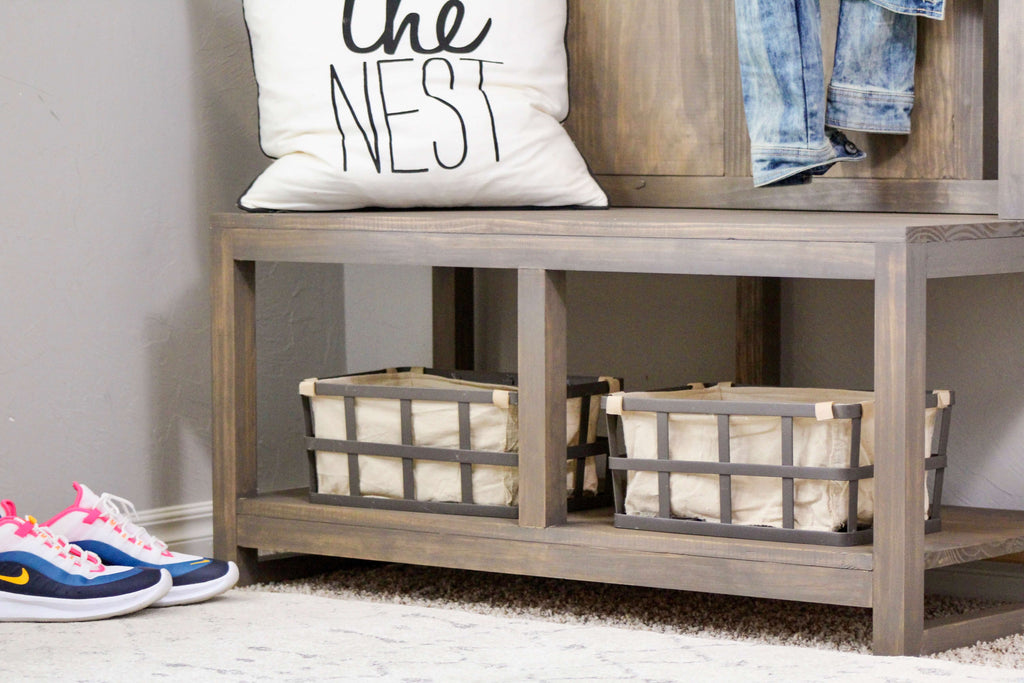
But before you head over, be sure to check out my process below of how I built this DIY hall tree.
I love all things modern, so I figured I would choose a design that was a little different from traditional hall tree benches that I’ve seen.
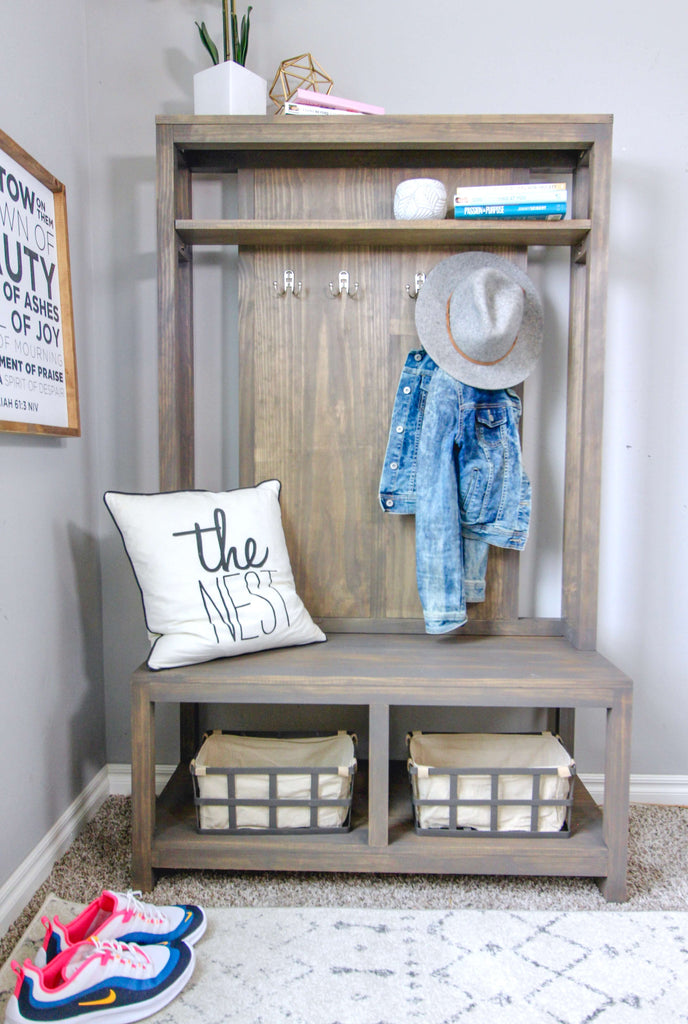 I saw this design online and just had to re-enact it. It can serve as storage, a coat rack and much more. The options are endless to what you can do with this DIY Hall Tree.
I saw this design online and just had to re-enact it. It can serve as storage, a coat rack and much more. The options are endless to what you can do with this DIY Hall Tree.

Also if you are looking for other great ideas for your entryway, be sure to check out some of my other plans posted up on the blog. All of my other entryway projects can be found here.
All of my other entryway projects can be found here.
There are some affiliate links in this post, meaning I get a small commission if you purchase through these links, at no cost to you. Click Here to read my full disclosure.
Dimensions
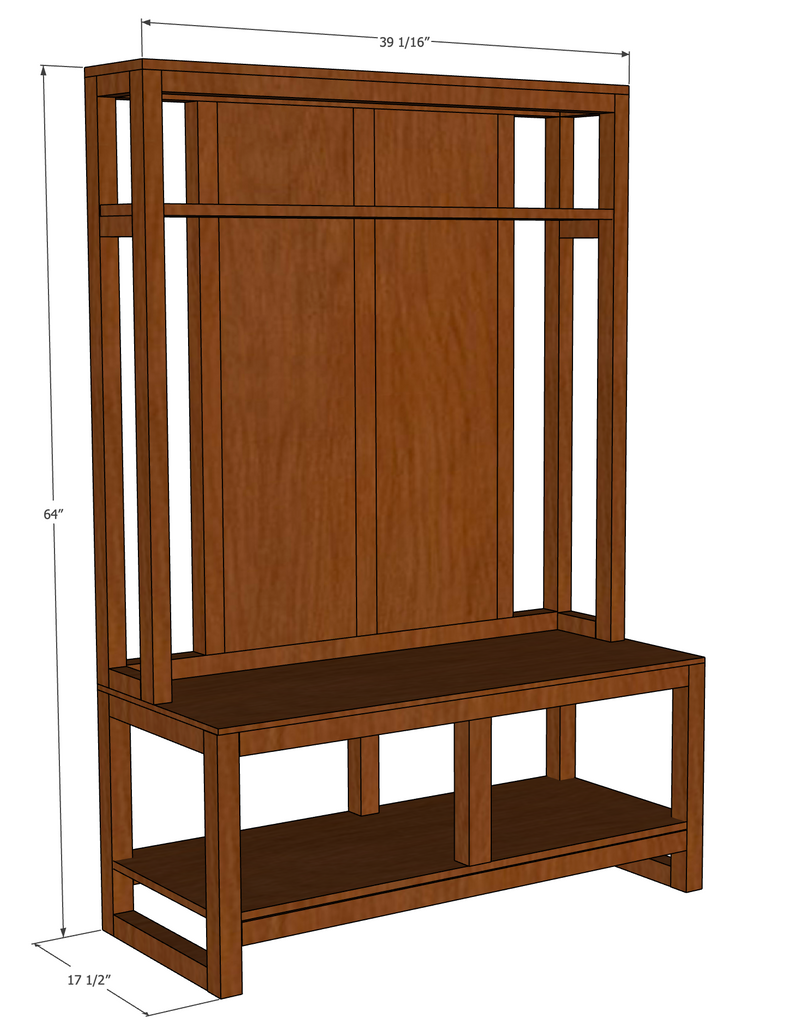
Supplies
13 - 2x2 @ 6ft
2 - 1x12 @ 6ft
2 - Panel Boards - 17.5" x 39"
2 - 1x8 @ 6ft
1 1/2" Brad Nails
Drill
For this build, I made an attempt to try and document my process through video just in case you guys wanted to give this DIY Hall Tree a go. Check out the video above and then be sure to head over to Build Something for the free plans on how I created this DIY Hall Tree Bench.
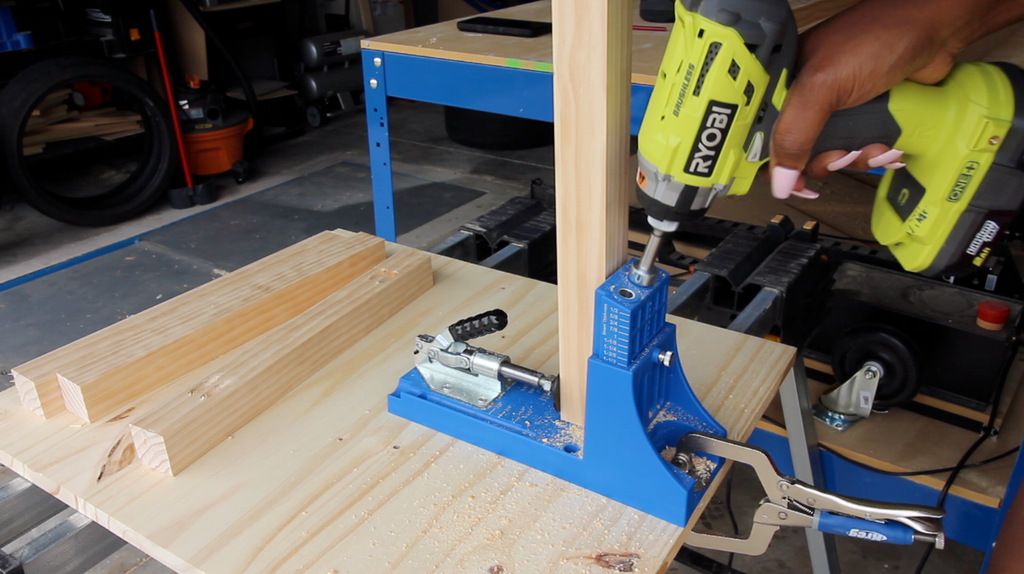 Of course, throughout this build, I utilized my handy dandy Kreg Jig. I say this often, but my Kreg Jig is one of my top tools that I use on most, if not all, of my builds and it’s a tool I highly recommend. I personally use the K4 master system and it hasn’t disappointed me yet.
Of course, throughout this build, I utilized my handy dandy Kreg Jig. I say this often, but my Kreg Jig is one of my top tools that I use on most, if not all, of my builds and it’s a tool I highly recommend. I personally use the K4 master system and it hasn’t disappointed me yet.
If you don't use pocket holes often and you're looking for a more simpler version of the Kreg Jig, the R3 Kreg model is a great alternative and a little cheaper. Another handy tool I utilized was my Kreg clamp. I am always flying solo when it comes to building, so those clamps definitely come in handy. I would recommend this clamp if you utilize pocket holes often.
Another handy tool I utilized was my Kreg clamp. I am always flying solo when it comes to building, so those clamps definitely come in handy. I would recommend this clamp if you utilize pocket holes often.
This hall tree was fairly easy to build; I completed it in one day. Although, it may take longer for some, it was a fairly easy project to tackle and I can’t wait to see you guys tackle it yourselves.
If you're wondering where I got this cool blue workbench from; I got it from Kreg. It is one of my favorite workbenches specifically because of the fact that I can roll it around in the shop and its just the right size to be able to build my projects on top of it, so I don't always have to build from the ground. Kreg really has some great products that I've used plenty of times throughout my building journey and I always get excited when I get the chance to partner together with them.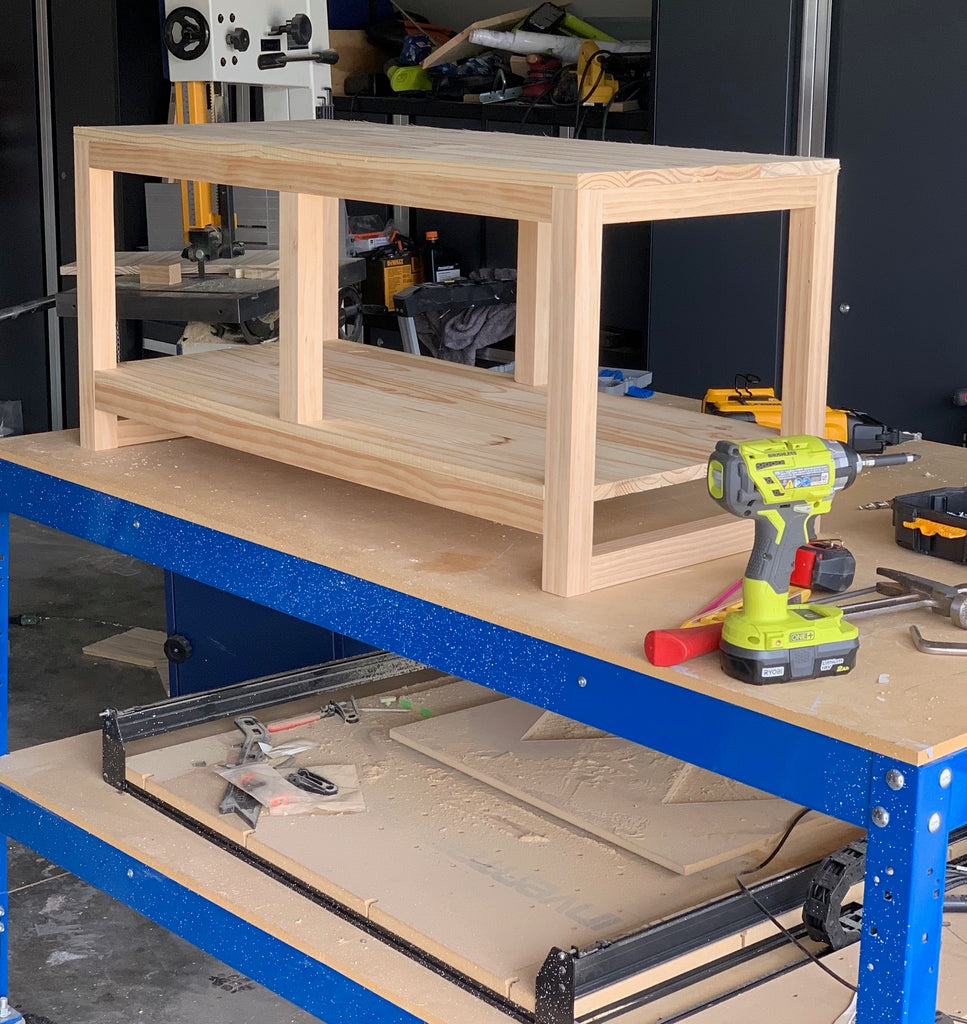 I opted to use Select Pine for this particular build because it makes it look really clean. It does drive up the price tag quite a bit, but in my opinion, it was well worth the extra money. I got it from my fav orange store, The Home Depot. Regular pine would work just fine for this build, but you may have to put in a little extra work to make it look as nice.
I opted to use Select Pine for this particular build because it makes it look really clean. It does drive up the price tag quite a bit, but in my opinion, it was well worth the extra money. I got it from my fav orange store, The Home Depot. Regular pine would work just fine for this build, but you may have to put in a little extra work to make it look as nice.
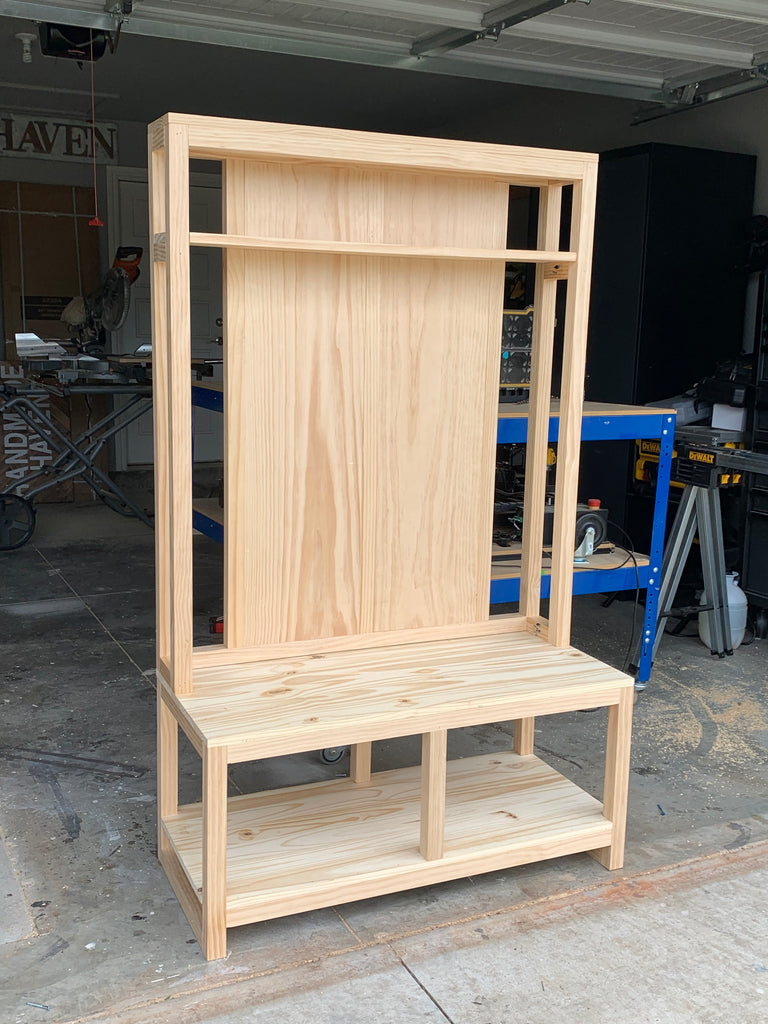 For the finish, I decided to go with one of my favorite stains, Rustoleum’s Briarsmoke. I love this stain color because it gives my build a modern, rustic look. Before applying the stain, I did wipe down the hall tree with a stain pre-conditioner first. This prevents any blotching on the build.
For the finish, I decided to go with one of my favorite stains, Rustoleum’s Briarsmoke. I love this stain color because it gives my build a modern, rustic look. Before applying the stain, I did wipe down the hall tree with a stain pre-conditioner first. This prevents any blotching on the build.
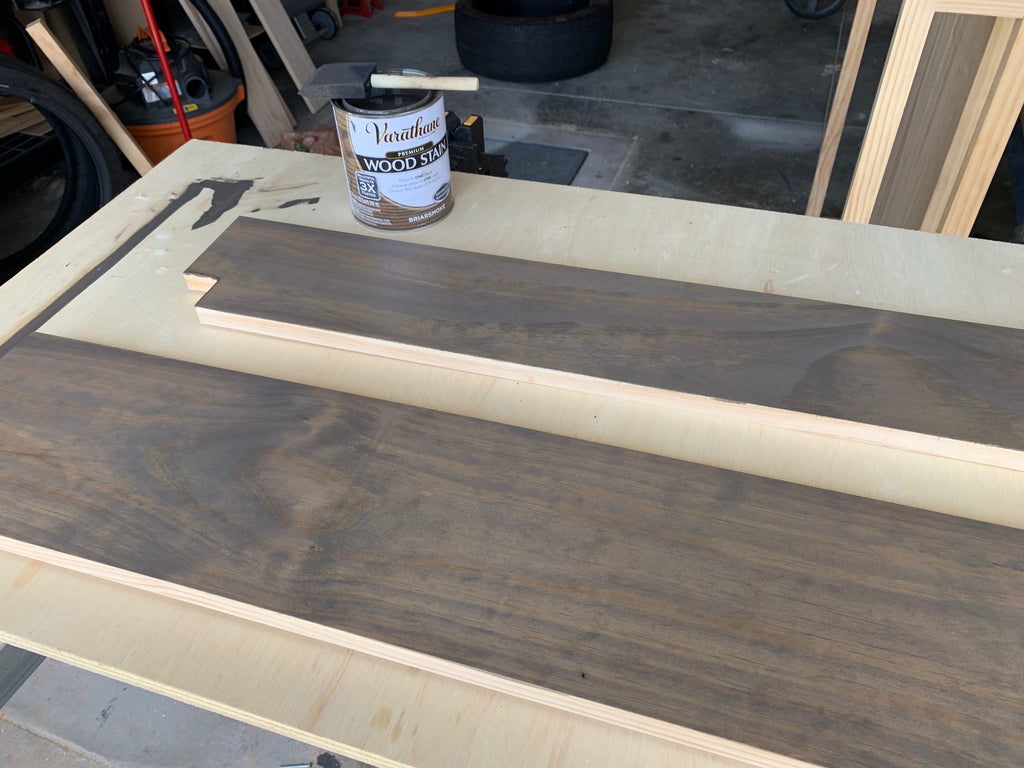 Before you head over for the free plans, let’s take one more look at this beauty. I’m really happy with how this DIY Hall Tree bench came out and I hope that you guys have fun building it as well.
Before you head over for the free plans, let’s take one more look at this beauty. I’m really happy with how this DIY Hall Tree bench came out and I hope that you guys have fun building it as well.
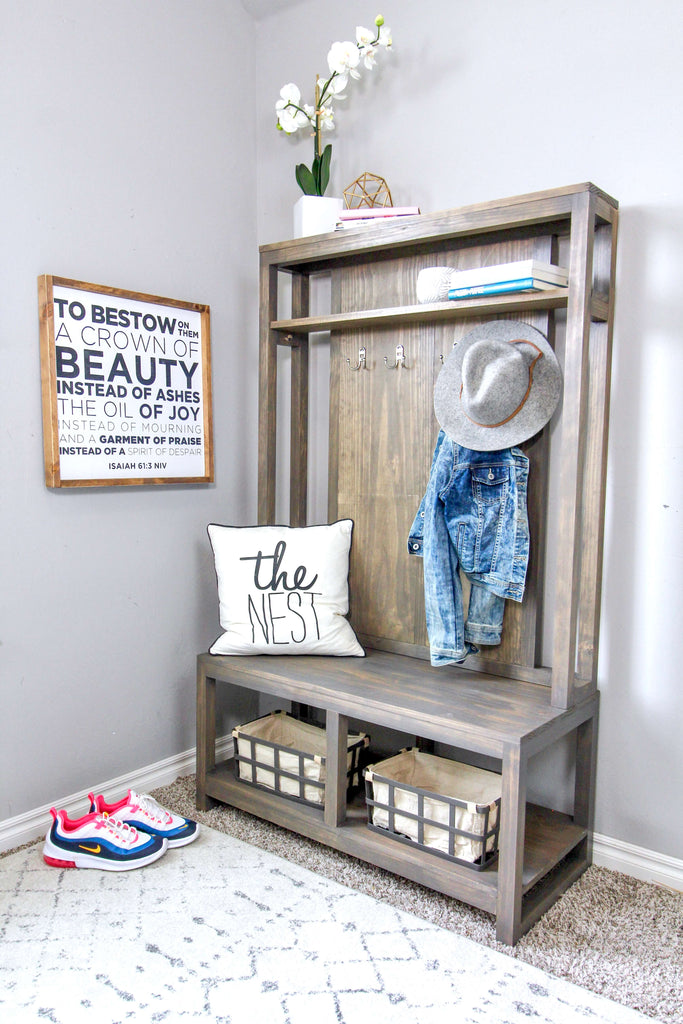
For the free plans, head on over to Build Something and enjoy!
But before you go, be sure to check out this other similar hall tree I built here.
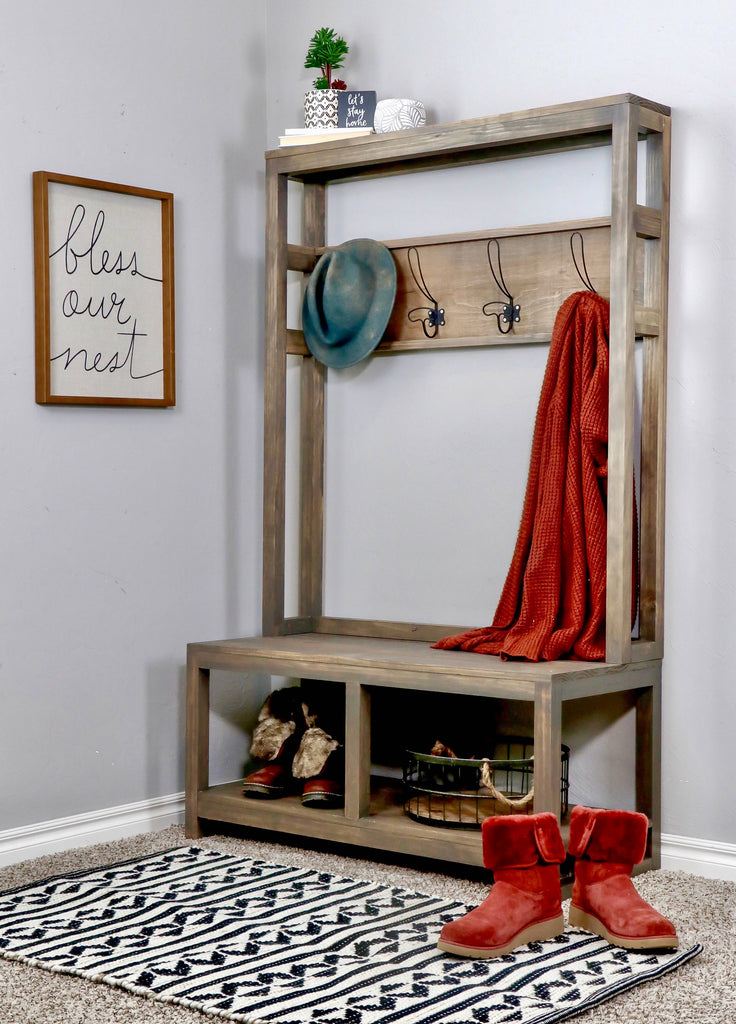 See you over at Build Something!
See you over at Build Something!
Thanks for reading guys and I can't wait to see all of your great builds.
XOXO Ashley

DIY Outdoor Coffee Table
"An outdoor coffee table with a little extra underneath."
Hey everyone! I’m Cara from The Inspired Workshop , and I am excited to be teaming up with Ashley to bring you a few projects this year! First up is the tutorial and plans for this DIY modern outdoor coffee table that has an optional sandbox for the kiddos!
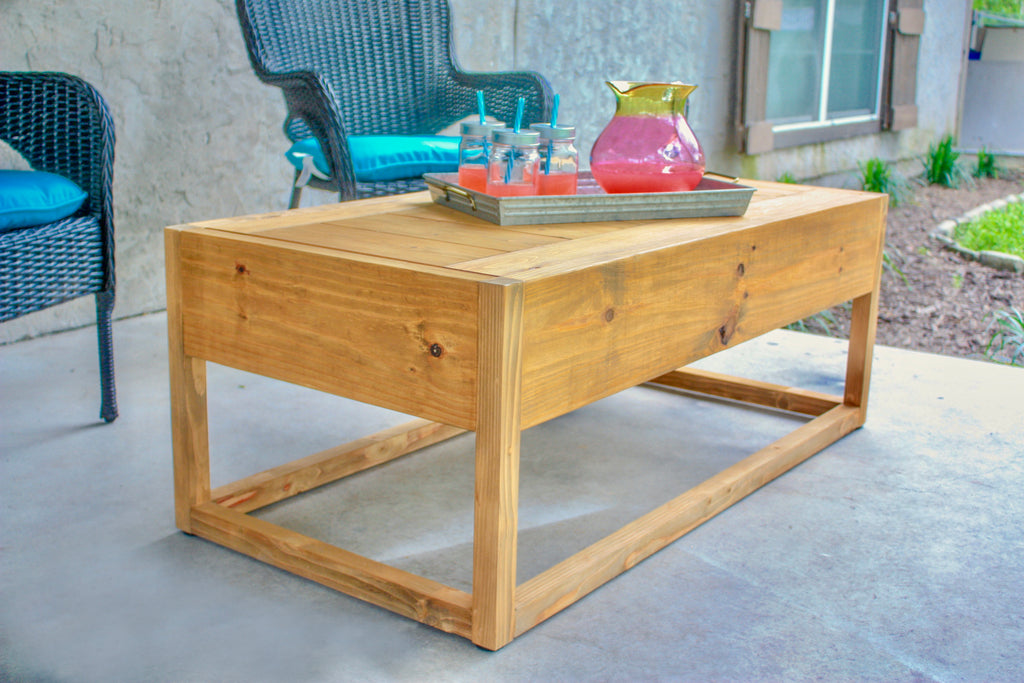
The build is simple and straightforward with only a few tools and materials needed. Plus the modern, sophisticated design of the coffee table easily hides the secret that it is a sandbox as well. I won’t tell anyone if you don’t! Lol! No more having to see the kids toys in the yard when you expertly disguise them into furniture!
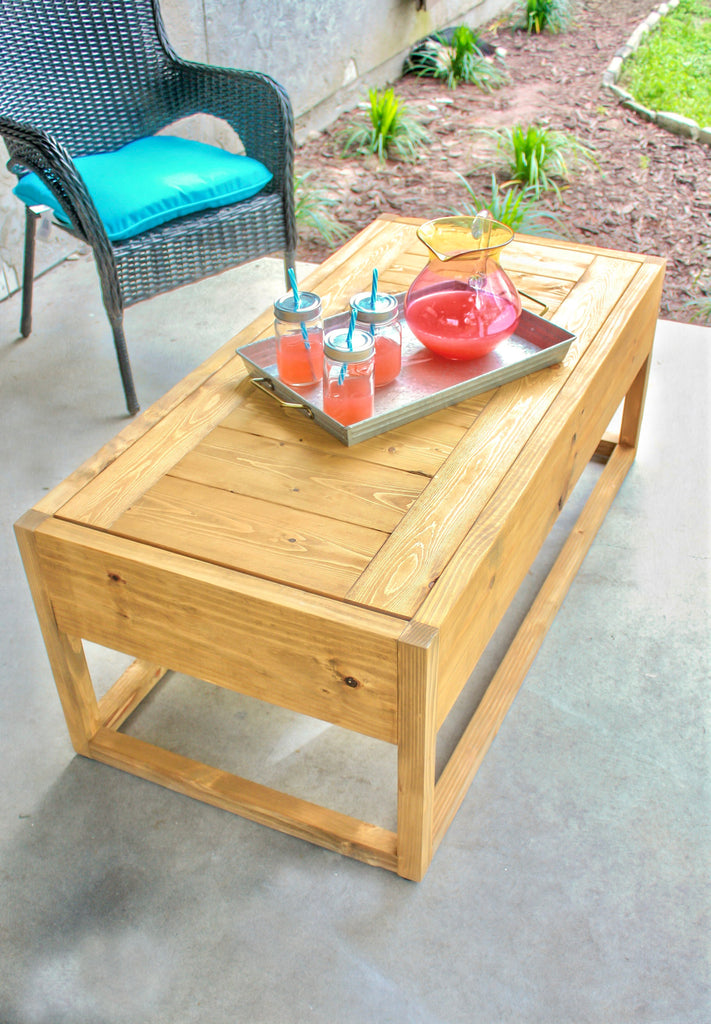
The materials and step by step tutorial are listed below, but if you would like the downloadable plans they are available and straight to the point! You may need to use both the blog post and printable plans if there is an instruction you don’t understand!
Are you ready to get building? I bet you are!
Materials:
- 2 - 2x8x8
- 3 - 2x2x8
- 4 - 1x6x8
- 1 - 1x4x8
- 2 - 1x2x8
- Kreg Jig
- Saw
- Drill
- Stain (I used Thompson Waterseal in Teak)
NOTE: If you would just like to make the coffee table without a sandbox the supplies will be altered by only needing 2 - 1x6x8, you won’t need the 1x2x2s or the 1x4x8 or the waterproof fabric.
Dimensions:
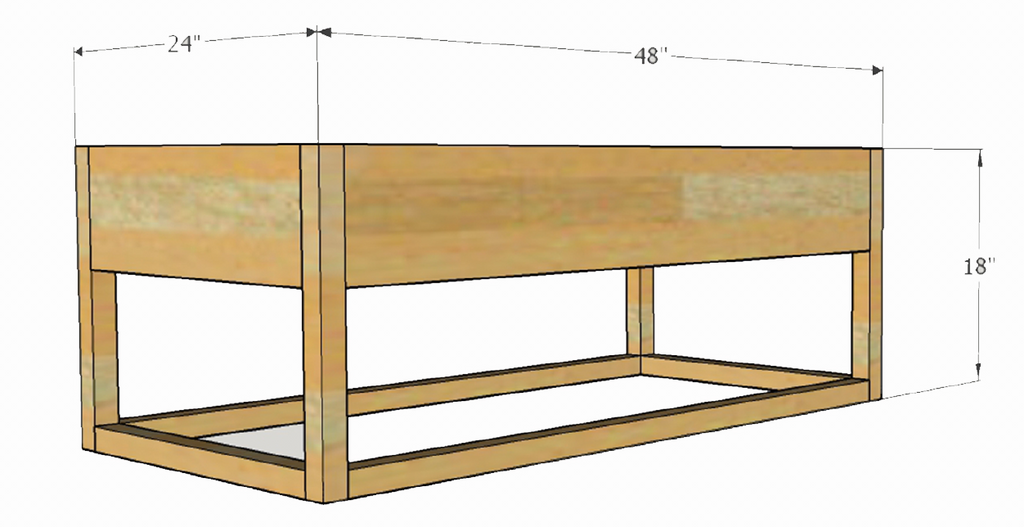
Cut List:
- 2 - 2x8 @ 45” - Front and back, top rails
- 2 - 2x8 @ 21” - Side, top rails
- 4 - 2x2 @ 18” - Legs
- 2 - 2x2 @ 45” - Front and back, bottom rails
- 2 - 2x2 @ 21” Side, bottom rail
- 8 - 1x6 @ 21” - bottom of sand box (optional ¾” plywood cut at 45” x 21” - using a 2x4
project panel, if you would like a solid bottom without a liner)
- 8 - 1x6 @ 13 ¾” - Lid Boards
- 2 - 1x4 @ 44 ½” - Lid Boards
- 2 - 1x2 @ 45” - Lid support boards
- 2 - 1x2 @19 ½” - Lid support boards
NOTE: If you want to build the coffee table without the sandbox, you can omit everything listed
after the 8 - 1x6 @ 21”.
Step 1
Cut and attach the boards for the front of the sandbox. Using your Kreg Jig , drill holes at a depth of 1 ½” and use wood glue along with 2 ½” pocket hole screws to attach. Blue Kote screws are specifically made to use in outdoor projects.
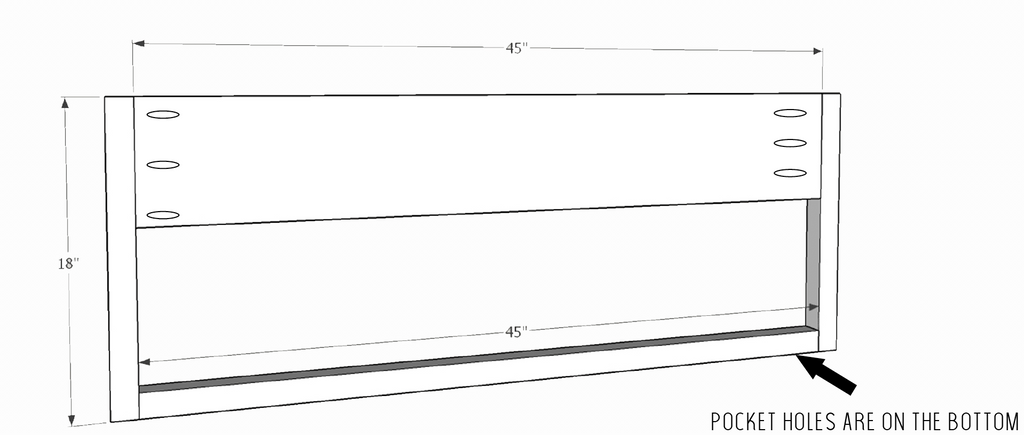
The bottom 2x2 has the pocket holes placed to the bottom of the table!
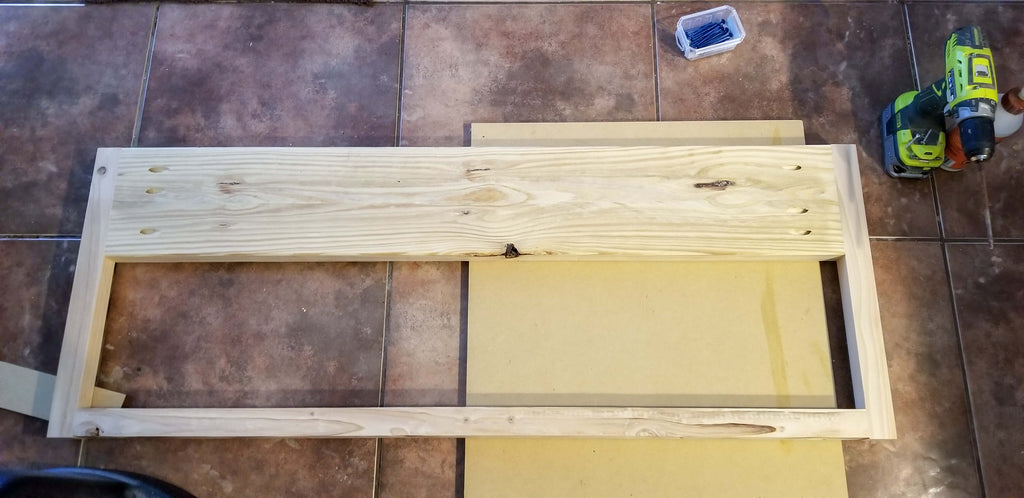
Flip it over, and Viola! It looks great already!
Step 2
Build another panel just like you did in Step 1, you will then have a front and back!

Step 3
Join the front of the table to the back of the table by adding the sides! You will still be using using a Kreg Jig K4 Pocket Hole System on a 1 1/2" setting, with 2 1/2" Pocket Hole Screws to attach along with wood glue. I attached the side boards (1 - 2x8 @ 21”, 1 - 2x2@21”) to each side of the top and then flipped it over and added the back.

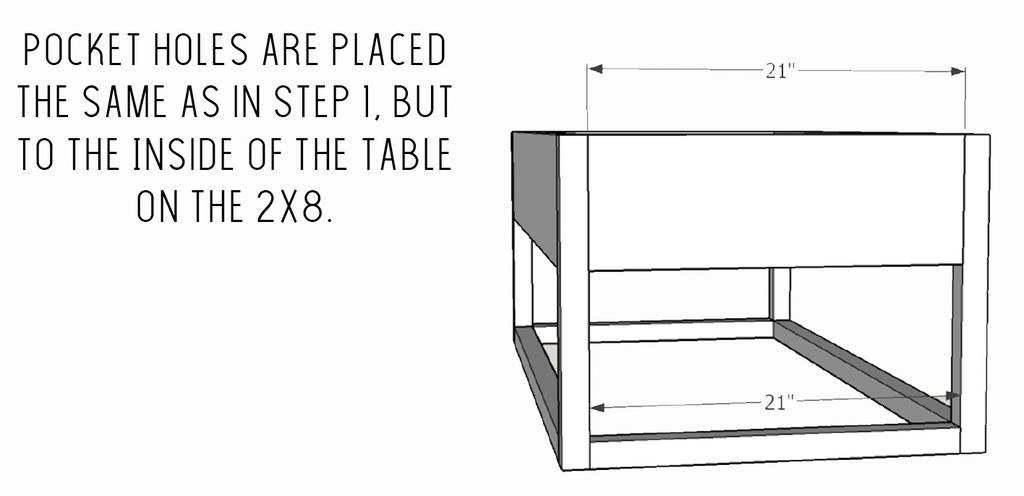
Once it is all attached, it really starts to take shape!

Step 4
Add the bottom 1x6 boards to create a solid surface for the liner to rest on. At first I thought it would be best to have the single boards spaced out to allow drying of the liner, but as I was building, I really came to the conclusion that it probably wouldn’t matter if you just used a solid piece of plywood, as long as it is properly sealed!
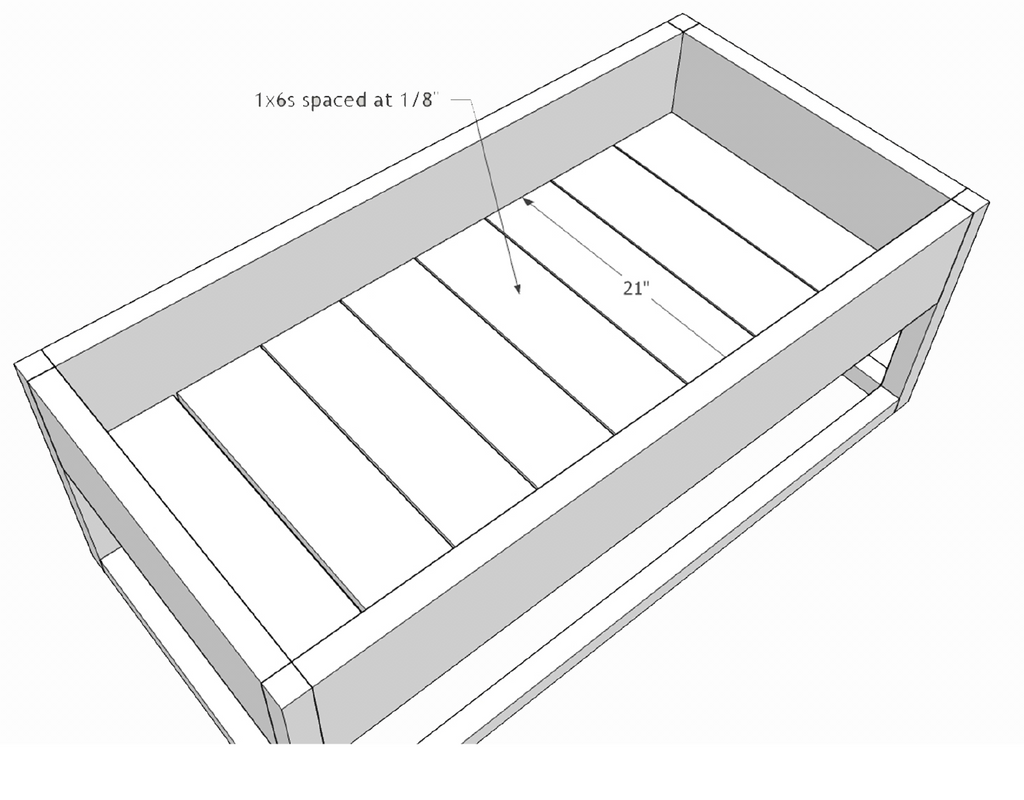
Since I used the single boards I will show you how I did it, the idea would be the same if you used a sheet of plywood. I drilled pocket holes at a depth of ¾” and used wood glue and 1 ¼” Blue Kote screws to attach.
I roughly spaced the boards ⅛” apart. I just cut a sliver of a board at about ⅛” and used that to space them all the same. The pic below shows the sandbox flipped over, which is how I attached the boards. They were a snug enough fit I didn’t have to do anything special to get them to stay in place while I screwed them in.
Don’t mind how shabby the bottom of the boards look! Lol! I was using up some not so great 1x6s I had laying around since they won’t be seen!
While the table was flipped over, I added the rubber feet here...and somehow managed to not take pictures! Ugh! But it is pretty easy, I centered the rubber foot on each 2x2 ‘leg’ and screwed it in with the screws provided. The rubber feet measure 1 ½” so they center perfectly on the leg.
NOTE: If you would like to build the coffee table without the sandbox, you can just attach those
1x6s you cut for the bottom of the sandbox and attach them as the top of the table, and boom...you’re done! Essentially it would look like this!
Step 5
At this point I sanded and stained the table so that I wouldn’t have to worry about trying the keep the stain off the liner. I then used polyurethane on the inside boards that would be beneath the liner. After comparing the poly to the Thompson Waterseal , I really could have used the Waterseal on both parts and saved myself the time of using the poly, it took forever to dry!
Step 6
I built the lid to the sandbox while all that was drying. The lid is a really simple design that allows the sand to air out to help reduce the chances of mold growing. I am not certain just yet as to how the outdoor fabric is going to hold up to the mold issue but I will try to update the post as time has passed!
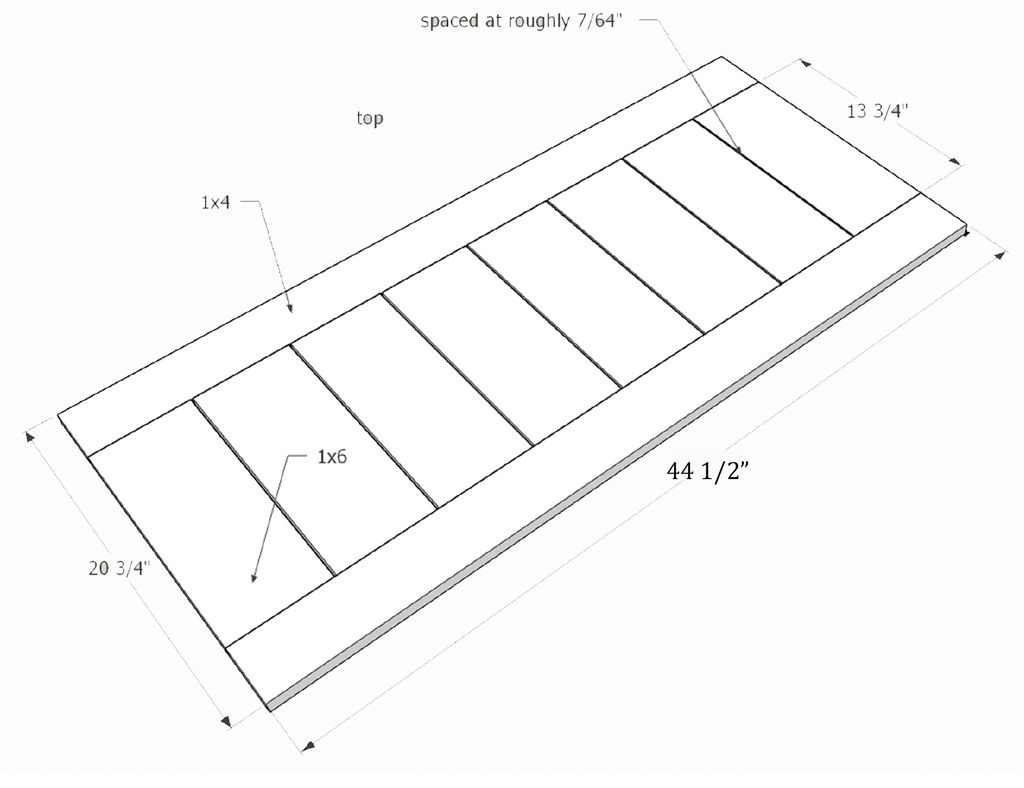
You will attach all the lid boards to each other (not to the table) with the same ¾” pocket hole setting , wood glue and 1 1/4" Pocket Hole Screws. I started by attaching the two end boards first and then spaced them out from there!
The boards will be spaced at roughly a little less than ⅛” but more than 1/16”... the computer says 7/64” but that seems a little crazy for me to space, so I went with a hair over 1/16” and just have slightly larger gaps towards the center boards. For some strange reason, probably pure excitement, I didn’t get pictures of the lid before staining! Lol! So here’s the sketchup version for you!
Step 7
Attach the liner to the inside of the sandbox using a staple gun. If you used a solid piece of plywood, you don’t have to do this step! I bought 1 yard of fabric and didn’t cut it at all as I placed it inside, just stapled it and then cut it with an exacto knife .


Last step was to add the lid support boards. I just screwed them in ¾” down from the top so that the lid would fit perfectly flush with the top!
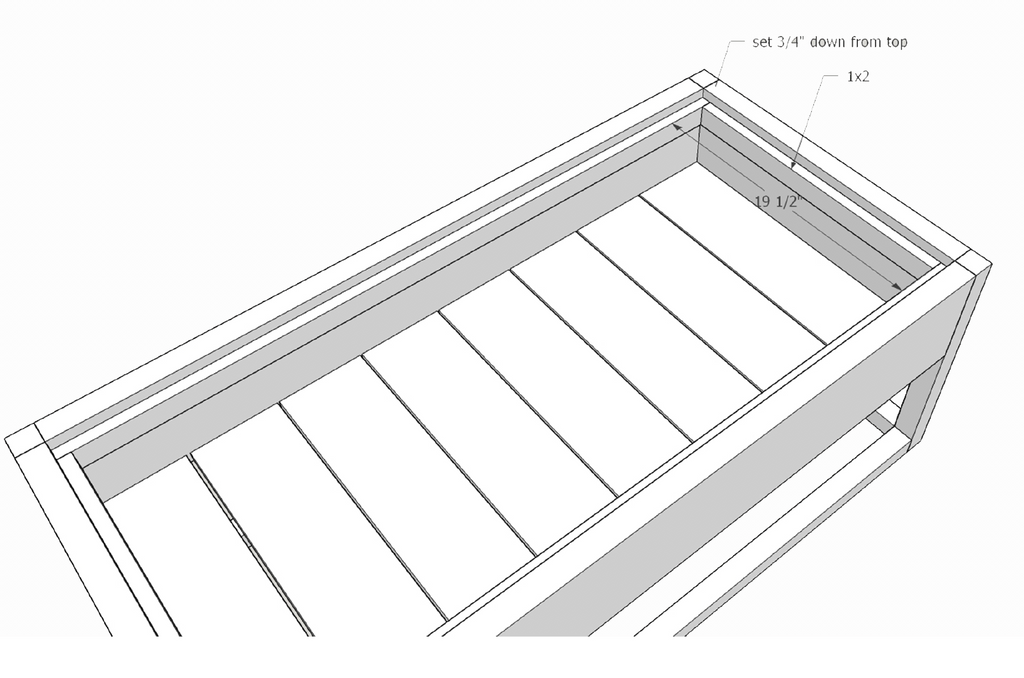
I did not glue the lid support boards, I figured if the fabric didn’t hold up well, I could easily remove the liner and replace it! I just screwed 1 ½” screws into the boards, as you can see the heads in the pictures!
You will need to seal the boards to keep the moisture from getting to them! Guess what?! Place the lid on top, and... it’s done! The kiddos are happy, momma is happy...what more could you ask for?! Lol!
Ah yes, a refreshing drink...that’s what else you could ask for! Lol!
One thing I will note… I adjusted the measurements to allow for ½” instead of a ¼” on the lid size so you can get a finger in to grab the lid and remove it, you may want to add a handle or something to make removing the lid easier. I love the sleek look and didn’t want to add a handle, but it is kinda hard if you place the lid inside the bottom like I did in the picture below! I just lifted the sandbox up slightly and then was able to remove it!

Ooh, it is so cute!
I hope you enjoyed the build! I can’t wait to come back and share another project with you all, but feel free to come visit me over at The Inspired Workshop in the meantime! See you soon!
3 Simple DIY Plant Stands
With spring in full swing, it’s the perfect time to bring fresh decor into your home. One of the most popular decor trends that's showing no sign of stopping are house plants. There are many different ways to incorporate plants in your home, some people fill their space to create a lush urban jungle while others go for a more minimalist approach. Whatever your style is there’s sure to be a plant for you.
One of the best ways to bring out your personal style is by displaying your plant on a stylish plant stand. Some of these store-bought stands can be super pricey or look mass produced. For a frugal and personalized look, consider creating your own DIY plant stand using one of these three simple tutorials. Each of the projects’ materials can be found in a hardware store and can be completed in less than a day.
DIY Tomato Cage Stand
This stand’s thin frame gives it a chic and clean look. Before purchasing a pot, make sure that you measure it’s circumference so you know it’s big enough to not fall through the smallest ring of the tomato cage you pick.
Materials needed:
- Tomato cage
- Bolt cutters
- Spray paint
- Potted plant
 Step 1: Use the bolt cutters to cut the ground-end prongs off of the tomato cage. Try to make your cut as clean as possible, you may need to file down any sharp edges.
Step 1: Use the bolt cutters to cut the ground-end prongs off of the tomato cage. Try to make your cut as clean as possible, you may need to file down any sharp edges.
 Step 2: Spray paint the tomato cage with the color of your choice. Metallics like rose gold or copper give the cage a more glamorous look while bright colors, like coral or aqua are great for a trendy playful look.
Step 2: Spray paint the tomato cage with the color of your choice. Metallics like rose gold or copper give the cage a more glamorous look while bright colors, like coral or aqua are great for a trendy playful look.

Step 3: Apply extra coats of paint if any metal shows through and let the tomato cage dry for about an hour. Once it’s dry place it wide side down.
 Step 4: Place your potted plant in the smallest ring of the cage and enjoy your new plant stand!
Step 4: Place your potted plant in the smallest ring of the cage and enjoy your new plant stand!

DIY Wood Crate Plant Stand
This wood crate stand is very versatile and can be used as shelving for books and other storage.
Materials needed:
- Wood crates
- Paint
- Hammer
- Nails
- Plants
 Step 1: Pick your paint color(s) and paint the crates. For best results, prime your crates and apply 2–3 coats depending on the opacity of the paint.
Step 1: Pick your paint color(s) and paint the crates. For best results, prime your crates and apply 2–3 coats depending on the opacity of the paint.
 Step 2: Let the crates dry for a couple hours. Once they are completely dry, stack the crates and find your desired formation. Make sure to try this out in the space you plan putting the completed project to make sure it fits.
Step 2: Let the crates dry for a couple hours. Once they are completely dry, stack the crates and find your desired formation. Make sure to try this out in the space you plan putting the completed project to make sure it fits.
 Step 3: After finalizing your formation, nail the crates in place. Make sure to use the right length nail to ensure that the nail doesn’t poke through to the other side.
Step 3: After finalizing your formation, nail the crates in place. Make sure to use the right length nail to ensure that the nail doesn’t poke through to the other side.

Step 4: Arrange your plants on your crate stand and enjoy!

DIY Copper Pipe Stand
The shape and finish of this DIY copper pipe stand gives off a mid-century modern look, try using a matte silver pipe finish for an industrial look. Note: some stores may cut the pipe for you when you purchase and others will ask you to buy a simple pipe cutting tool that’s very easy to use.
Materials needed:
- Pre-cut copper pipes + attachments
- 4 copper pipes at 1 inch long and ½ inch wide
- 4 copper pipes at 4 inches long and ½ inch wide
- 4 copper pipes at 5 inches long and ½ inch wide
- 4 copper pipes at 10 inches long and ½ inch wide
- 8 copper T-brackets at a ½ inch wide
- 8 copper pipe caps at a ½ inch wide
- Super glue
- Potted plant
 Step 1: Assemble and glue the base, then let it dry. The copper pieces needed to assemble the base are:
Step 1: Assemble and glue the base, then let it dry. The copper pieces needed to assemble the base are:
- 4 copper pipes at 1 inch long and ½ inch wide
- 4 copper pipes at 4 inches long and ½ inch wide
- 4 copper T-brackets at a ½ inch wide
Build the inner square first, one half at a time and then to attach the extending pipes after. Start with one half of the inner square, glue the 1-inch pieces to the T-brackets, then assemble the other half and glue the two halves together. Once dry, glue the 4 inch pipes into the remaining T-bracket slots.
 Step 2: Assemble and glue the legs and let them dry. The copper pieces needed to assemble the legs are:
Step 2: Assemble and glue the legs and let them dry. The copper pieces needed to assemble the legs are:
- 4 copper pipes at 5 inches long and ½ inch wide
- 4 copper pipes at 10 inches long and ½ inch wide
- 4 copper T-brackets at a ½ inch wide
Glue one 5 inch pipe and one 10 inch pipe to either end of the T-bracket, leave the perpendicular slot open. Attach the copper pipe caps to the exposed ends of the 5 inch pipe and 10 inch pipe. Repeat these steps until you have four legs.
 Step 3: Attach the legs to the base with glue and let them dry. Glue an open T-brackets on the leg piece to an end of the 4 inch pipe that extends from the base. Repeat this until all of the legs are attached to the base, let the plant stand dry.
Step 3: Attach the legs to the base with glue and let them dry. Glue an open T-brackets on the leg piece to an end of the 4 inch pipe that extends from the base. Repeat this until all of the legs are attached to the base, let the plant stand dry.
 Step 4: Once the glue has set (after an hour or so) add your potted plant to the stand and display your new project.
Step 4: Once the glue has set (after an hour or so) add your potted plant to the stand and display your new project.

For more details on these planters and styling tips, check out the full DIY plant stand tutorials or the infographic by ProFlowers below:

Floral Serving Tray
"Whether Easter, Spring or Summer, this DIY serving tray is sure to put all of your guest in good spirits."
With Easter around the corner, I figured I'd do a fun project to commemorate the event. But this floral serving tray applies to more seasons than just one. I am excited to share this fun DIY with you guys today.
"This post is sponsored by the Home Depot as a part of The Home Depot's Pro-Spective Campaign."

Whether you want to display food or have a fun space for displaying your drinks, this DIY floral serving tray will surely elevate any table setting. The best part is that you can continually change out the flowers for each event r season, making it a project that's always new and fresh.
There are some affiliate links in this post, meaning I get a small commission if you purchase through these links, at no cost to you. Click Here to read my full disclosure.

Materiels
2 - 1x4x6 Select Pine Board
1 - 1x3x8 Select Pine Board
1 - 2x4 1/2" MDF Board
Floral Foam
Artificial Flowers
8 - White Picket Fences
White Acrylic Paint
Paint Brush
Painters Tape
Tools
Bandsaw

Luckily, I got this project all on video so be sure to check out the video tutorial after reading through the post.
Step 1: Assemble Outer Tray Box
The first thing I did was assemble the outer tray box. I used my brad nailer and 1" brad nails to assemble it together. I first started attaching the two 1x4s ( 16 7/8") to the 1/2" MDF bottom (16 7/8" x 16 7/8"). Then I added the two 1x4 outer side pieces (18 1/4) to the MDF bottom.
I used 1" brad nails to attach the pieces together. For more strength, you can also use wood glue for extra strength.
Step 2: Assemble Inner Box
Next, I started assembling the inner box. I used my Makita Impact Drill and Kreg Jigto pre-drill pocket holes into the sides of the inner box. The Makita Brushless Impact Driver features variable 2-speed and has 1,240 in.lbs of max torque in an ergonomic and compact design. The Makita Impact driver kit comes packed with a bag, charger and battery.
I drilled two pocket holes in each outer side of the 1x3s. Next I used a brad nailer to attach the four 1x3 (12 1/2") pieces together. Again, use wood glue for extra strength. Note: Make sure the pocket holes our facing outward and that the pocket holes are in the downward position.
One the inner box was assembled I started drilling the inner tray to the our tray using 1 1/4" pocket hole screws and my Makita Impact Drill
Step 3: Adding Floral Foam
Next, I cut down the floral foam on the bandsaw to fit into the sides of the food tray.

This doesn't have to fit perfectly, it just needs to be full enough to place the flowers in so it looks full. As you can see I had a few gaps between my foam.
I used a hot glue gun to hold the foam in place. You don't need a whole lot of glue fr this, just a few drops to keep the foam secure.
Step 4: Add White Picket Fences
Next step is to start adding the white picket fences. I used a hot glue gun to add the picket fences to the sides of the serving tray.
Be sure to make sure you don't put the hot glue all the way to the top of the picket fences because the top of the fence shows through on top.
Step 5: Add Flowers
Now this is the fun part. I used all types of artificial flowers to fill up the foam around the serving tray.
The flowers really made the serving tray pop, I can't get over just how good this looks. The flower arrangements really turned out better than expected.
I couldn't help but think of all the other things I could do with this project, It would also serve as a unique photo frame. Im sure my mom would love this for Mother's Day with a pic of us in the middle.

Step 6: Paint Tray Bottom
And the final step for this DIY is to paint the bottom of the serving tray white. Use painters tape to tape off the sides, and using a paint brush, paint the bottom of the tray white.

And TAA-DAH project is finished.

Serving snacks never looked so good. This fun DIY was a quick way to bring a lot of pizzazz to my table setting and the best part is that it's fitting for multiple occasions.



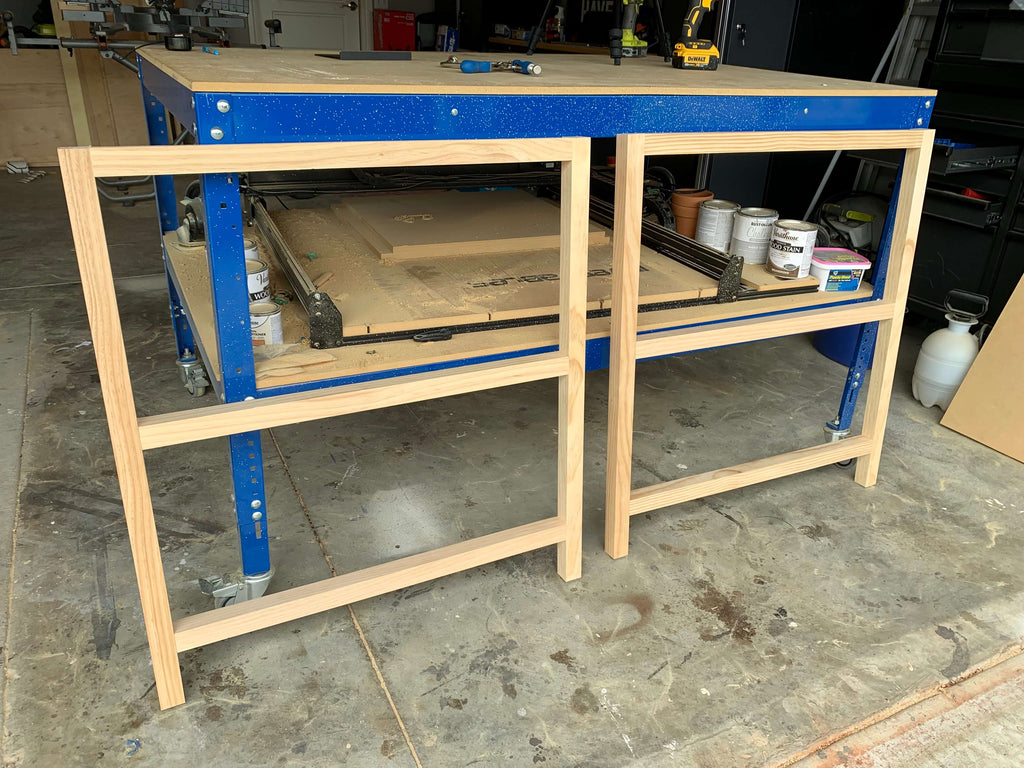

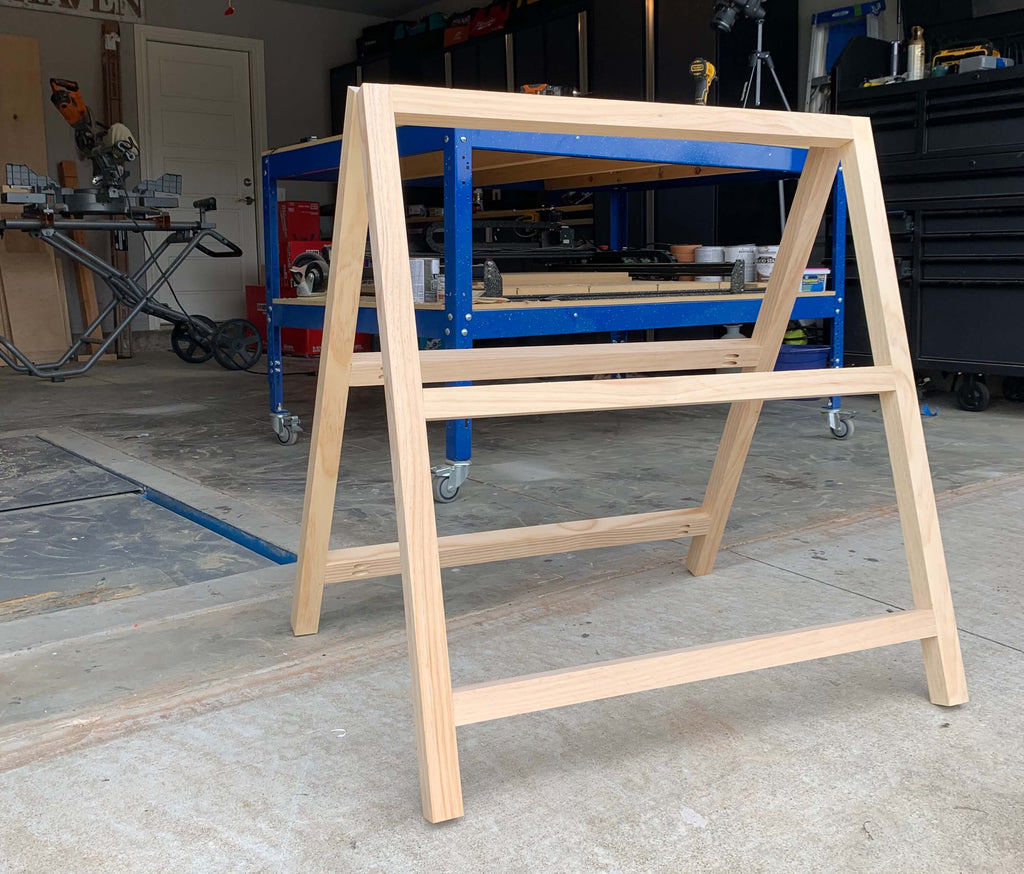
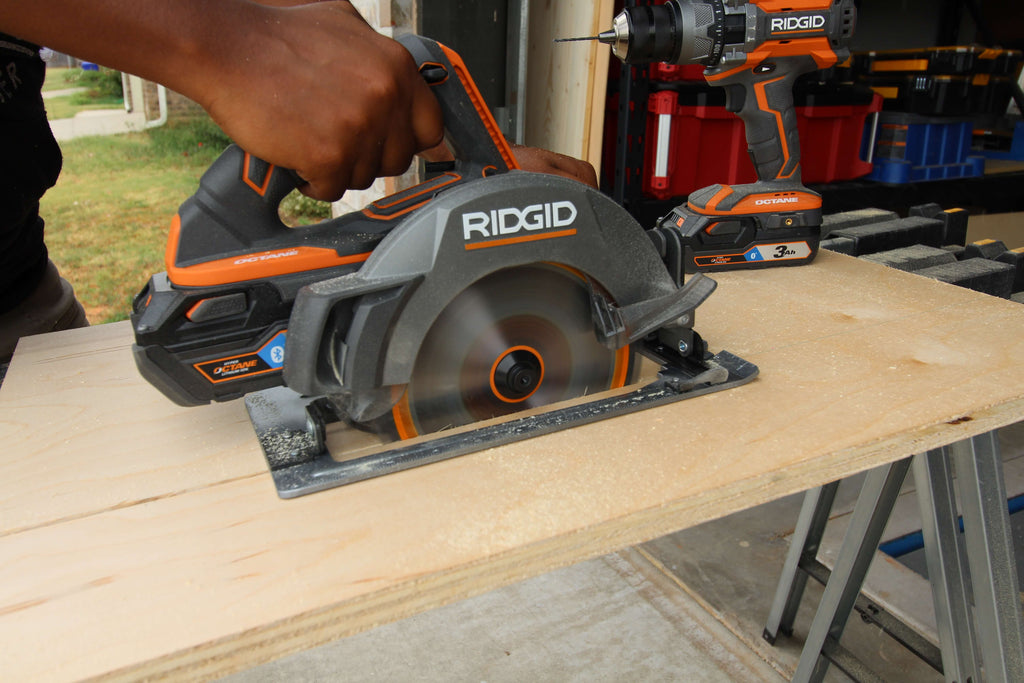
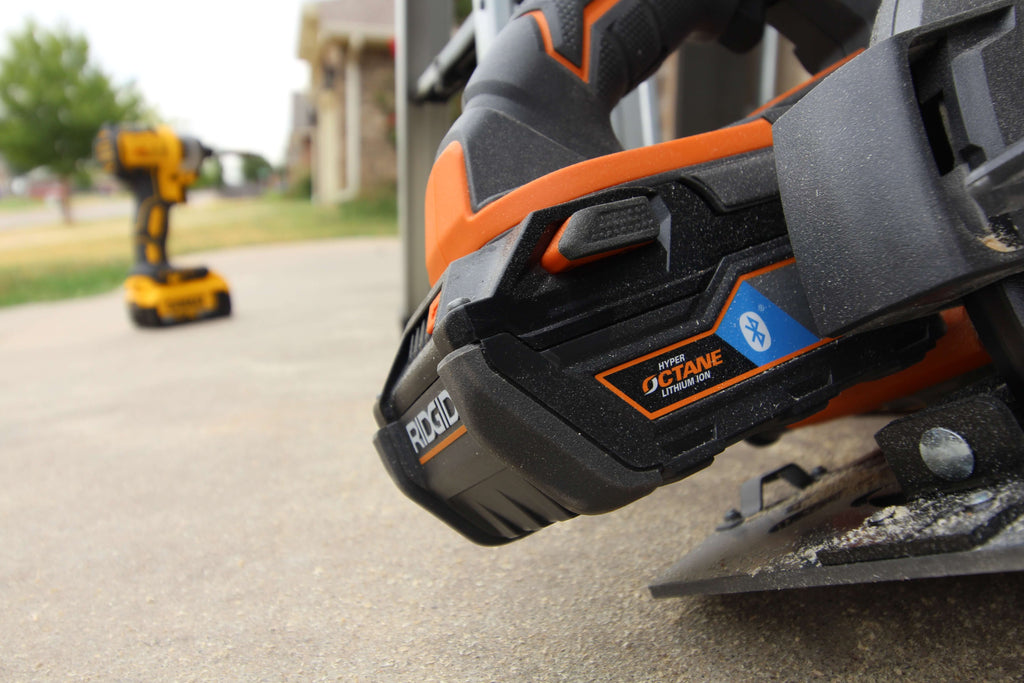
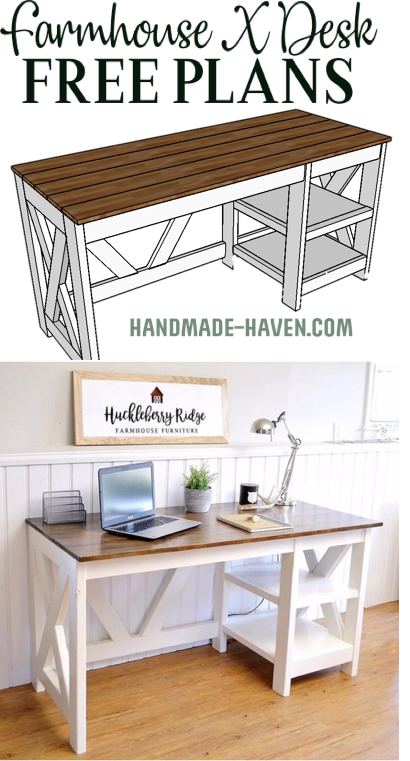

 Step 2: Assemble Wall Planter Backing
Step 2: Assemble Wall Planter Backing
















